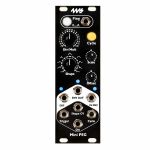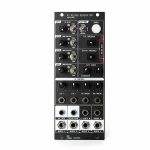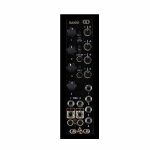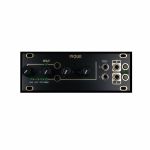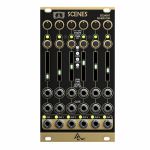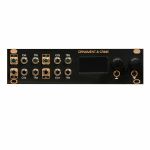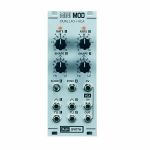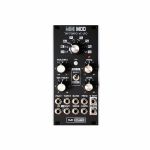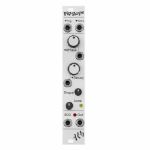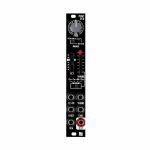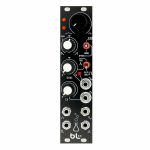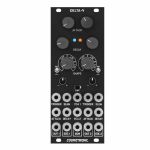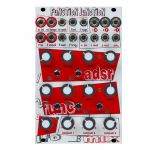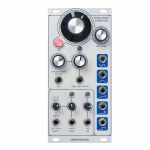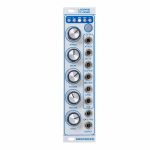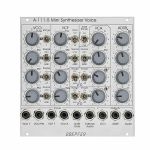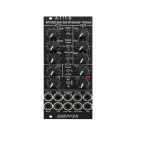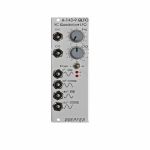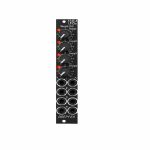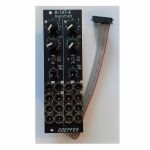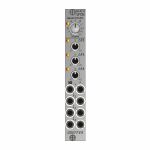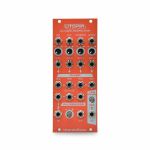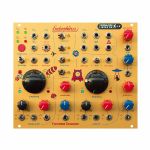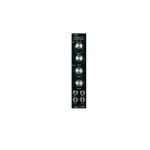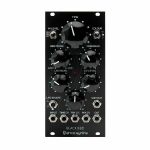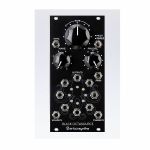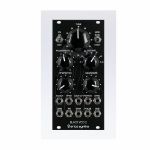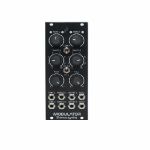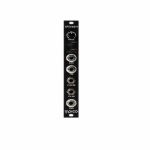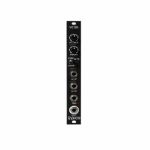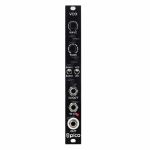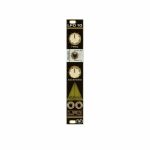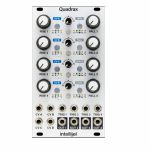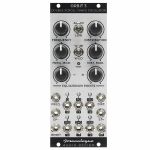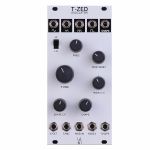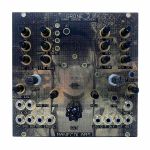100% Compra Segura
Studio equipment
Our full range of studio equipment from all the leading equipment and software brands. Guaranteed fast delivery and low prices.
100% Compra Segura
DJ equipment
Our full range of DJ equipment from all the leading equipment and software brands. Guaranteed fast delivery and low prices. Visit Juno DJ
Filter
Stock
Brand
Featured
Price
Tags
73
LFO module
26
Envelope generator module
26
Oscillator module
13
CV modulation module
11
Clock generator module
9
Function generator module
8
Random module
8
VCO module
7
VCA module
6
Frequency divider module
6
Sequencer module
5
Clock modulator module
5
Drum module
5
Noise module
5
Waveshaper module
4
Slew limiter module
4
Synth voice module
3
Filter module
3
Quantizer module
3
Sample & hold module
2
Attenuator module
2
Controller module
2
Mixer module
2
Phaser module
1
Delay module
1
Distortion module
1
Effects module
1
Envelope follower module
1
Expander module
1
Multiple module
Synth modules
The Eurorack modular synth format is one of the most exciting areas of music technology. Pioneered by Doepfer, there are now hundreds of brands offering compatible modules of all varieties. You can combine your choice of the best oscillators, filters and much more in order to create a unique, bespoke synth setup which perfectly suits your needs.
Eurorack modules offer the biggest range of options you can imagine, from basic analogue modules which replicate the sound of classic vintage synths, through to digital modules which allow you to explore completely new approaches to making music.
Whether you’re a beginner or a more experienced modular head, you can take your pick of the best modules from leading brands including Mutable Instruments and ALM Busy Circuits.
Our range also includes accessories, cases, patch cables and much more, allowing you to build and customise your perfect modular synth setup.

4ms Mini PEG Clock-Synced Envelope Generator & LFO Module (clock modulator/envelope generator/function generator synth module)
Cat: 901314 Rel: 29 Sep 22
The Mini PEG is a clock-synced envelope generator and LFO whose envelope times are set by the time between clock pulses or "pings".
Notes: The Mini PEG is a clock-synced envelope generator and LFO whose envelope times are set by the time between clock pulses or "pings". The Mini PEG is the latest version of the classic 4ms Pingable Envelope Generator.
Specs
Mini PEG
8HP Eurorack format module
0.95" (24mm) maximum depth (includes power cable)
16-pin Eurorack power header
Power consumption
+12V: 55mA
-12V: 30mA
Envelope Outputs
Maximum voltage range (ENV OUT): -9.4V to +9.4V
Maximum amplitude (ENV OUT): 9.5Vpp
Voltage range (5V OUT): 0V to +5V
Frequency range: +/-0.1dB DC to 1kHz, -1.0dB@2.5kHz, -2.0dB@4kHz
12-bit, 40kHz sample rate
Clock Range
Period range: 29.16 hours to 250us (4kHz)
CV Inputs (Div/Mult and Shape)
Voltage range: -5V to +5V
Gate Inputs (Ping, Trigger, Cycle)
Rising edge threshold: 2.5V
… Read moreSpecs
Mini PEG
8HP Eurorack format module
0.95" (24mm) maximum depth (includes power cable)
16-pin Eurorack power header
Power consumption
+12V: 55mA
-12V: 30mA
Envelope Outputs
Maximum voltage range (ENV OUT): -9.4V to +9.4V
Maximum amplitude (ENV OUT): 9.5Vpp
Voltage range (5V OUT): 0V to +5V
Frequency range: +/-0.1dB DC to 1kHz, -1.0dB@2.5kHz, -2.0dB@4kHz
12-bit, 40kHz sample rate
Clock Range
Period range: 29.16 hours to 250us (4kHz)
CV Inputs (Div/Mult and Shape)
Voltage range: -5V to +5V
Gate Inputs (Ping, Trigger, Cycle)
Rising edge threshold: 2.5V
1 in stock $149.35
Click for better price!
or call +44 20 7424 1960
quote 901314
quote 901314
4ms SWN Spherical Wavetable Navigator 6-Channel Synthesiser Module (black) (oscillator/digital/LFO/synth voice synth module)
Cat: 648377 Rel: 29 Apr 19
Six-channel synthesiser module - 26HP
Notes: The Spherical Wavetable Navigator (SWN) is a six-channel synthesiser that makes it easy to create slowly morphing drones, polyphonic melodies, evolving sequences, and rich textures.
The SWN features six wavetable oscillators with independent pitch, level, and waveform controls. Six LFOs (Low Frequency Oscillators) can be used as modulation sources and/or envelopes, making it easy to add dynamic motion to your patch. Each channel is a full voice and can be "played" using the top row of buttons, the internal LFOs, or note-change detection on the 1V/oct jacks. The SWN ships with 12 three-dimensional (spherical) wavetables and an easy interface which allows you to record and edit custom wavetables from live audio. Open-source software for Mac, Windows, and Linux called SphereEdit can be freely downloaded and allows you computer to create, edit, and convert .wav files into Spherical wavetables to transfer into the SWN with an audio cable.
New firmware available which adds extra features, visit https://4mscompany.com/p.php?p=820&c=5 for details.
… Read moreThe SWN features six wavetable oscillators with independent pitch, level, and waveform controls. Six LFOs (Low Frequency Oscillators) can be used as modulation sources and/or envelopes, making it easy to add dynamic motion to your patch. Each channel is a full voice and can be "played" using the top row of buttons, the internal LFOs, or note-change detection on the 1V/oct jacks. The SWN ships with 12 three-dimensional (spherical) wavetables and an easy interface which allows you to record and edit custom wavetables from live audio. Open-source software for Mac, Windows, and Linux called SphereEdit can be freely downloaded and allows you computer to create, edit, and convert .wav files into Spherical wavetables to transfer into the SWN with an audio cable.
New firmware available which adds extra features, visit https://4mscompany.com/p.php?p=820&c=5 for details.
1 in stock $562.18
Click for better price!
or call +44 20 7424 1960
quote 648377
quote 648377
Acid Rain Technology Maestro 6-Channel Clocked Modulation Controller Module (clock generator/clock modulator/controller/CV modulation/envelope generator/LFO/random/sequencer module)
Cat: 804571 Rel: 22 Jan 21
6-channel clocked modulation module
Notes: Maestro is a 6 channel clocked modulation controller inspired by the automation lanes found in digital audio workstation software, brought into eurorack and made playable and performable. Maestro will push and pull the parameters of your other modules with rapid or slowly evolving voltages, always in perfect sync with eachother and the rest of your system.
Details:
20hp
25mm deep
65mA on +12, 18mA on -12, 0mA on 5V
… Read moreDetails:
20hp
25mm deep
65mA on +12, 18mA on -12, 0mA on 5V
1 in stock $393.11
Click for better price!
or call +44 20 7424 1960
quote 804571
quote 804571
ADDAC System ADDAC405 VC Relabi Generator Module (black) (clock generator/clock modulator/LFO/quad/comparator synth module)
Cat: 797099 Rel: 17 Dec 20
Clock generator/clock modulator/LFO/quad/comparator synth module
Notes: Complex gate and CV generator designed as a trigger source and modulation tool. Based around four sine wave LFOs that mix together and interact to create ever-changing patterns.
Supplier's Notes:
In 2009 John Berndt coined and defined the term Relabi in his essay "Relabi": Patterns of Self-Erasing Pulse, these are his own words: "Relabi, Def.: The experience of a palpably coordinated plurality of events that appears to be cyclical but simultaneously suspends identification of a uniform pattern, preventing a resolved sense of pulse. Relabi therefore seems equally pulsed and unpulsed at the same time. It is an experiential gestalt, a quality of experience, greater than the sum of its parts (it forms a sustained unity in experience, albeit of a new kind)."
He also makes the question: "Why would anyone want this Relabi experience? I maintain that much of what is exciting in musical forms involves an interplay between the setting up and denying of pulse expectations."
Inspired by this idea, ADDAC System developed this module that is both a gate/trigger and cv generator that can be freely used to trigger events or act as a complex modulation source. Four Sine LFOs are internally generated, each has controls for gain, frequency and mute(off). These 4 LFOs are then mixed together to generate what Berndt named the "Relabi Wave" this "wave" becomes a complex bipolar CV source. This i5v bipolar "wave" can be monitored on the 2 dedicated leds and is also available at its own Output.
Make sure to check the User's Guide for indepth description, working behaviour and diagrams.
Tech Specs:
10HP
4cm deep
100mA +12V
40mA -12V
… Read moreSupplier's Notes:
In 2009 John Berndt coined and defined the term Relabi in his essay "Relabi": Patterns of Self-Erasing Pulse, these are his own words: "Relabi, Def.: The experience of a palpably coordinated plurality of events that appears to be cyclical but simultaneously suspends identification of a uniform pattern, preventing a resolved sense of pulse. Relabi therefore seems equally pulsed and unpulsed at the same time. It is an experiential gestalt, a quality of experience, greater than the sum of its parts (it forms a sustained unity in experience, albeit of a new kind)."
He also makes the question: "Why would anyone want this Relabi experience? I maintain that much of what is exciting in musical forms involves an interplay between the setting up and denying of pulse expectations."
Inspired by this idea, ADDAC System developed this module that is both a gate/trigger and cv generator that can be freely used to trigger events or act as a complex modulation source. Four Sine LFOs are internally generated, each has controls for gain, frequency and mute(off). These 4 LFOs are then mixed together to generate what Berndt named the "Relabi Wave" this "wave" becomes a complex bipolar CV source. This i5v bipolar "wave" can be monitored on the 2 dedicated leds and is also available at its own Output.
Make sure to check the User's Guide for indepth description, working behaviour and diagrams.
Tech Specs:
10HP
4cm deep
100mA +12V
40mA -12V
1 in stock $251.01
After Later Audio Baker Peaks Redesigned Module (enveolpe generator/LFO/drum synth module)
Cat: 805024 Rel: 14 Jan 21
Peaks with CV inputs and attenuverters in 6HP.
Notes: A 6HP version of Mutable Instruments Peaks that adds CV inputs and attenuverters for each of the four parameters.
It can be an ADSR-style envelope generator, an LFO and a drum emulator. By default, the Dead Man's Catch (DMC) firmware will be loaded, which adds the Alt ENV, ALT LFO, ALT Tap, Alt Drum modes below.
The module is calibrated, comes with a power cable, and a one year warranty.
Additional Dead Man's Catch firmware modes:
Basic (original modes):
Envelope
LFO
Tap LFO
Bass/Snare Drums
Alternative ENV:
Double attack envelope
Repeating attack envelope
Looping envelope
Randomized AD envelope
Bouncing ball envelope
Alternative LFO:
Frequency-modulated LFO (folded sine FM)
Frequency-modulated LFO (random FM)
Varying wave shape LFO ( folded sine WS mod)
Varying wave shape LFO ( random WS mod)
Phase-locked loop oscillator
Alternative TAP Mini-sequencer:
ModSequencer
Pulse Shaper
Pulse Randomizer
Turing Machine
Bytebeats
Alternative DRUM:
FM drum Generators
Randomized bass and snare drum generators
Randomized high hat
… Read moreIt can be an ADSR-style envelope generator, an LFO and a drum emulator. By default, the Dead Man's Catch (DMC) firmware will be loaded, which adds the Alt ENV, ALT LFO, ALT Tap, Alt Drum modes below.
The module is calibrated, comes with a power cable, and a one year warranty.
Additional Dead Man's Catch firmware modes:
Basic (original modes):
Envelope
LFO
Tap LFO
Bass/Snare Drums
Alternative ENV:
Double attack envelope
Repeating attack envelope
Looping envelope
Randomized AD envelope
Bouncing ball envelope
Alternative LFO:
Frequency-modulated LFO (folded sine FM)
Frequency-modulated LFO (random FM)
Varying wave shape LFO ( folded sine WS mod)
Varying wave shape LFO ( random WS mod)
Phase-locked loop oscillator
Alternative TAP Mini-sequencer:
ModSequencer
Pulse Shaper
Pulse Randomizer
Turing Machine
Bytebeats
Alternative DRUM:
FM drum Generators
Randomized bass and snare drum generators
Randomized high hat
2 in stock $171.13
Click for better price!
or call +44 20 7424 1960
quote 805024
quote 805024
After Later Audio Currents Tidal Modulator Module (envelope generator/LFO synth module)
Cat: 920672 Rel: 17 Jan 23
Full size version of Mutable Instruments Tides V2 (2020).
Notes: Full size version of Mutable Instruments Tides V2 (2020). It retains all of the original functionality of the full size version, both software and hardware. Its core is a triangle function generator and waveshaper that can be used as an LFO, oscillator, AD-style envelope generator (EG), and AR-style EG.
Based on open source designs by Emilie Gillet under Creative Commons (CC-BY-SA) license.
Width: 14hp
12V: 50mA
-12V: 20mA
… Read moreBased on open source designs by Emilie Gillet under Creative Commons (CC-BY-SA) license.
Width: 14hp
12V: 50mA
-12V: 20mA
1 in stock $205.36
Click for better price!
or call +44 20 7424 1960
quote 920672
quote 920672
After Later Audio Pique 1U Peaks Replica Module (digital/drum/envelope generator/LFO/sequencer synth module)
Cat: 805532 Rel: 14 Jan 21
Envelope/LFO/tap LFO/Drum generator module/rebuild of Mutable Instruments Peaks
Notes: Pique (uPeaks) 1U Intellijel Format
This is a 1U (Intellijel format) version of the Pique module which is based on the popular Peaks module from Mutable Instruments. It can be an ADSR-style envelope generator, an LFO and a drum emulator.
The module is calibrated, comes with a power cable, and a one year warranty.
… Read moreThis is a 1U (Intellijel format) version of the Pique module which is based on the popular Peaks module from Mutable Instruments. It can be an ADSR-style envelope generator, an LFO and a drum emulator.
The module is calibrated, comes with a power cable, and a one year warranty.
1 in stock $161.55
Click for better price!
or call +44 20 7424 1960
quote 805532
quote 805532
Cat: 805530 Rel: 14 Jan 21
Envelope/LFO/tap LFO/Drum generator/rebuild of Mutable Instruments Peaks
Notes: Pique (uPeaks)
Pique is a micro version (4HP) of the popular Peaks module from Mutable Instruments. It can be an ADSR-style envelope generator, an LFO and a drum emulator.
The module is calibrated, comes with a power cable, and a one year warranty.
… Read morePique is a micro version (4HP) of the popular Peaks module from Mutable Instruments. It can be an ADSR-style envelope generator, an LFO and a drum emulator.
The module is calibrated, comes with a power cable, and a one year warranty.
1 in stock $159.73
Click for better price!
or call +44 20 7424 1960
quote 805530
quote 805530
After Later Audio Scenes Segment Generator Module (CV modulation/envelope generator/LFO/sample & hold/sequencer/slew limiter sytnh module)
Cat: 949327 Rel: 07 Jun 23
An exact hardware replica of the Mutable Instruments Stages in 14HP.
Notes: Six segment generator. Looping or one shot envelope generator. Chainable, so it can be expanded to link multiple units.
An exact hardware replica of the Mutable Instruments Stages.
Dimensions
14 HP
25 mm deep
Current Draw
80 mA +12V
20 mA -12V
0 mA 5V
… Read moreAn exact hardware replica of the Mutable Instruments Stages.
Dimensions
14 HP
25 mm deep
Current Draw
80 mA +12V
20 mA -12V
0 mA 5V
1 in stock $267.60
Click for better price!
or call +44 20 7424 1960
quote 949327
quote 949327
After Later Audio SHTH Sample & Hold/Track & Hold Module (LFO/noise/sample & hold/utility synth module)
Cat: 857269 Rel: 09 Dec 21
Module that allows stepped output via sample & hold and track & hold techniques
Notes: SHTH - Sample and Hold - Track and Hold
Create stepped outputs using two different classic synthesis techniques, sample & hold and/or track & hold.
Sample & Hold
The top four jacks make up the sample and hold section. There is a noise output that is normalled to the input so you can pass a gate/trig signal into the SAMP input to get a stepped output at the OUT jack.
IN - Signal that will be sampled, normalled to NSE output
SAMP - When high updates the voltage being sent to the output
NSE - White noise output
OUT - The sampled output (freezes the value from the IN jack when the SAMP jack receives a high signal)
Track & Hold
The bottom four jacks make up the track and hold section. There is a walk signal (a randomish meandering voltage) that is normalled to the input. Track and hold is the opposite of sample and hold in that it will pass the IN value to the OUT jack until the TRACK input receives a high gate. While the TRACK input is high it will hold the value. After the TRACK input goes low, it will begin tracking the IN signal again.
IN - Signal that will be tracked
TRACK - When high the value will be held at the output
WALK - A meandering voltage
OUT - The track output (follows IN while TRACK is low, held voltage while TRACK is high)
… Read moreCreate stepped outputs using two different classic synthesis techniques, sample & hold and/or track & hold.
Sample & Hold
The top four jacks make up the sample and hold section. There is a noise output that is normalled to the input so you can pass a gate/trig signal into the SAMP input to get a stepped output at the OUT jack.
IN - Signal that will be sampled, normalled to NSE output
SAMP - When high updates the voltage being sent to the output
NSE - White noise output
OUT - The sampled output (freezes the value from the IN jack when the SAMP jack receives a high signal)
Track & Hold
The bottom four jacks make up the track and hold section. There is a walk signal (a randomish meandering voltage) that is normalled to the input. Track and hold is the opposite of sample and hold in that it will pass the IN value to the OUT jack until the TRACK input receives a high gate. While the TRACK input is high it will hold the value. After the TRACK input goes low, it will begin tracking the IN signal again.
IN - Signal that will be tracked
TRACK - When high the value will be held at the output
WALK - A meandering voltage
OUT - The track output (follows IN while TRACK is low, held voltage while TRACK is high)
1 in stock $85.05
Click for better price!
or call +44 20 7424 1960
quote 857269
quote 857269
After Later Audio uO_C 1U Micro Ornament & Crime Polymorphic CV generator Module (CV modulation/envelope generator/LFO/MIDI/quad/quantizer/random/utility module)
Cat: 862179 Rel: 02 Feb 22
Polymorphic CV generator module - 30HP
Notes: Ornament & Crime for 1U Intellijel format
This is functionally identical to the 3U version, just re-oriented to fit in 1U racks. Ornament & Crime is designed by mxmxmx.
The apps currently available in Ornament & Crime:
CopierMaschine is an enhanced version of the original quantising digital emulation of a four stage analogue shift register (ASR).
Harrington 1200 provides basic neo-Riemannian Tonnetz transformations of triadic chords, triggered by the digital (gate/trigger) inputs.
Automatonnetz combines Tonnetz transforms with a "vector" sequencer - it can be both a chord sequencer and a melody sequencer, but not of the usual kind.
Quantermain is a quad pitch quantiser for external voltages, with editable scales; it can do clocked (trigger-driven) quantising, or continuous quantising, with a latency of under 100 microseconds; it also features quad Turing Machines, May-Verhulst logistic maps or byte beats as optional, semi-random, internally generated CV sources.
Meta-Q is a dual-channel quantiser, similar to Quantermain, but also offering scale and note mask sequencing.
Quadraturia is a wavetable quadrature LFO, based on the "Easter egg" in the Mutable Instruments Frames module.
Low-rents is a dual Lorenz and Rossler (strange attractor) modulation generator, partially based on the "Easter egg" in the Mutable Instruments Streams module.
Piqued is a quad voltage-controlled envelope generator, based on envelope generator code from the Mutable Instruments Peaks module, but extending it with voltage control, additional envelope types, including re-triggering (looping) envelopes, additional segment shapes, adjustable trigger delays, and a unique Euclidean "trigger filter" which turns the app into a Euclidean rhythm generator which can output envelopes, not just gate or trigger pulses.
Sequins is a dual-channel step sequencer offering 4 "tracks" of up to 16 steps each; tracks can themselves be sequenced.
Dialectic Ping Pong is a quad bouncing ball envelope generator, based on a hidden mode of the Mutable Instruments Peaks module.
Viznutcracker, sweet! is a quad "byte beat" equation generator, which can be used as an audio source to generate curious but often interesting 8-bit noises and tunes, or which can be clocked by an external source to produce "byte beat" control voltage sequences. "Byte beats" were first described in 2011 by viznut (aka Ville-Matias Heikkila).
Acid Curds is both a chord quantiser (sometimes called a "harmonic quantiser" for external pitch voltages), and a chord progression sequencer.
References is an utility app that outputs specific reference voltages on each channel to help tune or calibrate VCOs and other modules. It also includes a high-precision frequency meter and note tuner, a high-precision BPM (beats per minute) tempo meter, and a closed-loop calibration mode.
Width: 30hp
12V: 85mA
-12V: 10mA
… Read moreThis is functionally identical to the 3U version, just re-oriented to fit in 1U racks. Ornament & Crime is designed by mxmxmx.
The apps currently available in Ornament & Crime:
CopierMaschine is an enhanced version of the original quantising digital emulation of a four stage analogue shift register (ASR).
Harrington 1200 provides basic neo-Riemannian Tonnetz transformations of triadic chords, triggered by the digital (gate/trigger) inputs.
Automatonnetz combines Tonnetz transforms with a "vector" sequencer - it can be both a chord sequencer and a melody sequencer, but not of the usual kind.
Quantermain is a quad pitch quantiser for external voltages, with editable scales; it can do clocked (trigger-driven) quantising, or continuous quantising, with a latency of under 100 microseconds; it also features quad Turing Machines, May-Verhulst logistic maps or byte beats as optional, semi-random, internally generated CV sources.
Meta-Q is a dual-channel quantiser, similar to Quantermain, but also offering scale and note mask sequencing.
Quadraturia is a wavetable quadrature LFO, based on the "Easter egg" in the Mutable Instruments Frames module.
Low-rents is a dual Lorenz and Rossler (strange attractor) modulation generator, partially based on the "Easter egg" in the Mutable Instruments Streams module.
Piqued is a quad voltage-controlled envelope generator, based on envelope generator code from the Mutable Instruments Peaks module, but extending it with voltage control, additional envelope types, including re-triggering (looping) envelopes, additional segment shapes, adjustable trigger delays, and a unique Euclidean "trigger filter" which turns the app into a Euclidean rhythm generator which can output envelopes, not just gate or trigger pulses.
Sequins is a dual-channel step sequencer offering 4 "tracks" of up to 16 steps each; tracks can themselves be sequenced.
Dialectic Ping Pong is a quad bouncing ball envelope generator, based on a hidden mode of the Mutable Instruments Peaks module.
Viznutcracker, sweet! is a quad "byte beat" equation generator, which can be used as an audio source to generate curious but often interesting 8-bit noises and tunes, or which can be clocked by an external source to produce "byte beat" control voltage sequences. "Byte beats" were first described in 2011 by viznut (aka Ville-Matias Heikkila).
Acid Curds is both a chord quantiser (sometimes called a "harmonic quantiser" for external pitch voltages), and a chord progression sequencer.
References is an utility app that outputs specific reference voltages on each channel to help tune or calibrate VCOs and other modules. It also includes a high-precision frequency meter and note tuner, a high-precision BPM (beats per minute) tempo meter, and a closed-loop calibration mode.
Width: 30hp
12V: 85mA
-12V: 10mA
1 in stock $243.75
Click for better price!
or call +44 20 7424 1960
quote 862179
quote 862179
AJH Synth Mini Mod Dual LFO & VCA Module (silver) (B-STOCK) (synth module)
Cat: 934445 Rel: 22 Mar 17
B-STOCK: Box opened, product unused & in perfect condition
Notes: ***B-STOCK: Box opened, product unused & in perfect condition***
This has two LFOs, each with variable waveshape from Saw to Triangle to Ramp waveforms, or variable Pulse width on the Square wave output. LFO 1 has the addition of a low range and a Sync input. The nominal maximum frequency of the LFOs when in Triangle shape is 20Hz, but under certain combinations of settings they will go much higher, well into audio range.
Also included is a DC coupled VCA, the input of the VCA is normalised to the output of LFO 2, so a 0 to +5V input to the VCA CV input gives control of the LFO waveform amplitude. It can also be used as a stand alone VCA.
This module is very useful for controllers such as the Waldorf KB37 where the modulation wheel gives out 0 to +5V, this can be routed to the VCA CV module so the level of the modulation waveform can be easily controlled. This makes it very easy to add VCO vibrato or filter 'wah' with control of modulation amount from the modulation wheel or other controller.
… Read moreThis has two LFOs, each with variable waveshape from Saw to Triangle to Ramp waveforms, or variable Pulse width on the Square wave output. LFO 1 has the addition of a low range and a Sync input. The nominal maximum frequency of the LFOs when in Triangle shape is 20Hz, but under certain combinations of settings they will go much higher, well into audio range.
Also included is a DC coupled VCA, the input of the VCA is normalised to the output of LFO 2, so a 0 to +5V input to the VCA CV input gives control of the LFO waveform amplitude. It can also be used as a stand alone VCA.
This module is very useful for controllers such as the Waldorf KB37 where the modulation wheel gives out 0 to +5V, this can be routed to the VCA CV module so the level of the modulation waveform can be easily controlled. This makes it very easy to add VCO vibrato or filter 'wah' with control of modulation amount from the modulation wheel or other controller.
2 in stock $153.26
AJH Synth MiniMod Multi Burst Envelopes Advanced Burst Generator Module (silver) (clockgenerator/clock modulator/CV modulation/envelope generator/LFO synth module)
Cat: 877175 Rel: 09 May 22
The MiniMod Multi Burst Envelopes module generates variable length bursts of repeating envelopes that can change over time, with CV control of all functions.
Notes: The MiniMod Multi Burst Envelopes module generates variable length bursts of repeating envelopes that can change over time, with CV control of all functions.
The BURSTS control selects a "Burst Sequence" of between 1 and 40 individual envelopes. The envelope shape of a burst is chosen with the rotary switch, or it can be varied using an external CV, so that it is even possible to chose a different envelope shape for each individual burst in a sequence.
The width of the envelope (i.e. the attack and decay time) is varied with the P-WIDTH control and this can also be CV controlled as a sequence is progressing, so it is possible to vary the envelope speed of each individual envelope burst while a Burst Sequence is running.
The repeat time of individual bursts in a Burst Sequence is set with the LFO Rate control. The LFO rate can be varied with an external CV as a sequence is progressing, so the gap between envelopes can speed up or slow down over time. An external clock can also time the bursts in a burst sequence instead of, or in addition to the internal LFO. Bursts can also be manually incremented with the CLK push button.
The SLOPE control allows Bursts to start quietly and build in level to maximum, or they can start at full level and then reduce in level as the Burst Sequence progresses. In the centre position all Bursts are of equal level.
Specifications
Module Width: 12hp
Module Depth: 26mm (Including power lead)
Current Usage: 28mA Positive, 12mA Negative
Individual Envelope Length: 20msecs to 2.5 seconds
Internal clock rate: Off, 0.24Hz to 51Hz, or every 4.2 seconds to every 20msecs
Envelope waveshapes: Sine, LogDown, LogUp, ExpoDown, RampUp, Triangle, RampDown, Pulse
Repeats: 1 to 40
Slope: bipolar, sloping up from 4%->100%, and sloping down from 100%->4%
… Read moreThe BURSTS control selects a "Burst Sequence" of between 1 and 40 individual envelopes. The envelope shape of a burst is chosen with the rotary switch, or it can be varied using an external CV, so that it is even possible to chose a different envelope shape for each individual burst in a sequence.
The width of the envelope (i.e. the attack and decay time) is varied with the P-WIDTH control and this can also be CV controlled as a sequence is progressing, so it is possible to vary the envelope speed of each individual envelope burst while a Burst Sequence is running.
The repeat time of individual bursts in a Burst Sequence is set with the LFO Rate control. The LFO rate can be varied with an external CV as a sequence is progressing, so the gap between envelopes can speed up or slow down over time. An external clock can also time the bursts in a burst sequence instead of, or in addition to the internal LFO. Bursts can also be manually incremented with the CLK push button.
The SLOPE control allows Bursts to start quietly and build in level to maximum, or they can start at full level and then reduce in level as the Burst Sequence progresses. In the centre position all Bursts are of equal level.
Specifications
Module Width: 12hp
Module Depth: 26mm (Including power lead)
Current Usage: 28mA Positive, 12mA Negative
Individual Envelope Length: 20msecs to 2.5 seconds
Internal clock rate: Off, 0.24Hz to 51Hz, or every 4.2 seconds to every 20msecs
Envelope waveshapes: Sine, LogDown, LogUp, ExpoDown, RampUp, Triangle, RampDown, Pulse
Repeats: 1 to 40
Slope: bipolar, sloping up from 4%->100%, and sloping down from 100%->4%
1 in stock $227.16
Click for better price!
or call +44 20 7424 1960
quote 877175
quote 877175
AJH Synth MiniMod Tap-Tempo VC-LFO Module (black) (clock generator/LFO synth module)
Cat: 882554 Rel: 23 Jun 22
The MiniMod Tap Tempo VC-LFO is a 12HP wide LFO with a huge range of useful features including Tap Tempo and internal / external clock control.
Notes: Ultra-versatile LFO module with tap tempo, internal/external clock support, 16 different waveforms and a clever Waveform Twist option, allowing a PWM-style effect.
Supplier's Notes:
The MiniMod Tap Tempo VC-LFO is a 12HP wide LFO with a huge range of useful features including Tap Tempo and internal / external clock control.
Sixteen different waveforms are available over two banks and an eight way rotary switch and Bank switch allow easy waveform selection.
The unique Waveform Twist function allows PWM like duty cycle variation to be applied to fifteen of the waveforms.
CV controllable multiply function - with this we can double, treble, quadruple or half the LFO rate, so that we can vary the modulation frequency but still keep it relative to the tempo of the track.
Large modulation range from 0.05Hz (one cycle every 20 seconds) to 50Hz
Random stepped voltages (similar to S&H) and also a very useful random sloped voltage outputs are also available.
Voltage control is implemented for all functions, including waveform selection and exponential control of modulation frequency
Bipolar and Unipolar outputs are available simultaneously and the built in VCA allows easy control of the modulation level of both outputs.
Module Width: 12hp
Module Depth: 26mm (Including power lead)
Current Usage: 35mA Positive, 25mA Negative
… Read moreSupplier's Notes:
The MiniMod Tap Tempo VC-LFO is a 12HP wide LFO with a huge range of useful features including Tap Tempo and internal / external clock control.
Sixteen different waveforms are available over two banks and an eight way rotary switch and Bank switch allow easy waveform selection.
The unique Waveform Twist function allows PWM like duty cycle variation to be applied to fifteen of the waveforms.
CV controllable multiply function - with this we can double, treble, quadruple or half the LFO rate, so that we can vary the modulation frequency but still keep it relative to the tempo of the track.
Large modulation range from 0.05Hz (one cycle every 20 seconds) to 50Hz
Random stepped voltages (similar to S&H) and also a very useful random sloped voltage outputs are also available.
Voltage control is implemented for all functions, including waveform selection and exponential control of modulation frequency
Bipolar and Unipolar outputs are available simultaneously and the built in VCA allows easy control of the modulation level of both outputs.
Module Width: 12hp
Module Depth: 26mm (Including power lead)
Current Usage: 35mA Positive, 25mA Negative
1 in stock $245.82
Click for better price!
or call +44 20 7424 1960
quote 882554
quote 882554
ALM Pip Slope MK2 Compact Envelope Generator Module (envelope generator/function generator/LFO synth module)
Cat: 792489 Rel: 21 Sep 20
envelope generator module
Notes: The ‘Pip Slope’ (rev II) is a compact envelope and function generator. It supports both Attack/Decay and Attack/Sustain/Decay type envelopes with both direct and voltage control of Attack and Decay times. Envelope shapes can be morphed between exponential, linear and logarithmic type slopes. Envelopes can be made to loop, repeating infinitely or decreasing with time or amplitude for echo and bouncing ball type effects. An ‘End of Cycle’ trigger output further extends the envelopes functionality for both clocking and burst or fill type effects.
The improved Pip Slope adds a number of new features and updates over the original Pip whilst keeping the same size. Improvements include increased output resolution, finer control of fast envelopes, a new morphing shape control, switchable 5v or 8v maximum envelope level, additional loop modes and an additional trigger output.
Features:
Compact envelope and function generator in 4HP.
Trigger and gate inputs.
Voltage and direct control of attack and release times.
Snappy or super long envelope times – ranging approx 1ms to 7 minutes per stage.
Optional self looping ability with 3 different loop modes: Decreasing amplitude, decreasing time, and regular loop.
Shape control that morphs the envelope shape from logarithmic to linear to exponential curves.
End of Slope trigger output that fires a trigger at the end the envelope or loop cycle.
Selectable 5v or 8v max envelope level output.
Reverse polarity protection.
Skiff friendly.
Designed and Made in the UK.
Technical Specifications
Supply: +12V 30mA / -12V 10mA
Size: 4HP
Depth: 38mm
… Read moreThe improved Pip Slope adds a number of new features and updates over the original Pip whilst keeping the same size. Improvements include increased output resolution, finer control of fast envelopes, a new morphing shape control, switchable 5v or 8v maximum envelope level, additional loop modes and an additional trigger output.
Features:
Compact envelope and function generator in 4HP.
Trigger and gate inputs.
Voltage and direct control of attack and release times.
Snappy or super long envelope times – ranging approx 1ms to 7 minutes per stage.
Optional self looping ability with 3 different loop modes: Decreasing amplitude, decreasing time, and regular loop.
Shape control that morphs the envelope shape from logarithmic to linear to exponential curves.
End of Slope trigger output that fires a trigger at the end the envelope or loop cycle.
Selectable 5v or 8v max envelope level output.
Reverse polarity protection.
Skiff friendly.
Designed and Made in the UK.
Technical Specifications
Supply: +12V 30mA / -12V 10mA
Size: 4HP
Depth: 38mm
7 in stock $106.83
ALM Quaid Megaslope 5-Stage Envelope LFO & Step Sequencer Module (silver) (CV modulation/envelope generator/LFO/sequencer/slew limiter synth module)
Cat: 688775 Rel: 31 Jan 19
Flexible five stage function generator - 19HP
Notes: The 'Quaid Megaslope' is a five stage function generator or modulator which operates in one of 3 modes; a multistage 'CZ' or 'Juno' style complex envelope, a super flexible LFO and a step sequencer with per step programmable slew or slides.
Each mode produces a varying output voltage moving from point to point across a set number of chained together stages. Each stage features a destination level, an overall rate or time to reach its destination level and a variable slope for the output path to take. As well as direct control, every stage feature voltage control of both level and rate. There are both unipolar and bipolar voltage outputs together with triggers emitted for the end of each stage and the end of a full cycle.
The Quaid Megaslope is designed to be fun, flexible and intuitive to use.
… Read moreEach mode produces a varying output voltage moving from point to point across a set number of chained together stages. Each stage features a destination level, an overall rate or time to reach its destination level and a variable slope for the output path to take. As well as direct control, every stage feature voltage control of both level and rate. There are both unipolar and bipolar voltage outputs together with triggers emitted for the end of each stage and the end of a full cycle.
The Quaid Megaslope is designed to be fun, flexible and intuitive to use.
1 in stock $235.45
Click for better price!
or call +44 20 7424 1960
quote 688775
quote 688775
Befaco Pony VCO Analogue Thru-Zero Wavefolding VCO/LFO Module (dynamics/LFO/oscillator/VCA/waveshaper synth module)
Cat: 898291 Rel: 26 Sep 22
Analogue Thru-Zero Wavefolding VCO/LFO
Notes: Pony VCO is a fully analogue Thru-Zero oscillator with wavefolder and dedicated VCA in only 4HP. The module offers great stability and tuning capabilities thanks to its powerful core, based on Sound Semiconductors IC. It comes with a range selector, that allows it to go down to LFO range, as well as octave and waveform selectors.
Pony VCO is also available in 1U format keeping the same functionality and control layout.
Features
Through Zero Frequency Modulation
Wavefolding (Timbre)
Pulsewidth Modulation (PWM)
SYNC
VCA
LFO
Specs
Current Draw: +12v: 32 mA -12v: 25mA
Width: 4HP
Deepth: 30mm including power connector
Aluminium, heat-treated front panel.
Designed and assembled in Barcelona.
In Through Zero oscillators, frequency is controlled by either positive and negative voltage. If FM CV goes below zero, the core will continue oscillating inverting its phase. This "little" change of behaviour allows the core to create a whole new range of timbres that are just impossible to achieve with regular VCOs.
If you set the module as LFO, the range of funky modulations will be endless!
… Read morePony VCO is also available in 1U format keeping the same functionality and control layout.
Features
Through Zero Frequency Modulation
Wavefolding (Timbre)
Pulsewidth Modulation (PWM)
SYNC
VCA
LFO
Specs
Current Draw: +12v: 32 mA -12v: 25mA
Width: 4HP
Deepth: 30mm including power connector
Aluminium, heat-treated front panel.
Designed and assembled in Barcelona.
In Through Zero oscillators, frequency is controlled by either positive and negative voltage. If FM CV goes below zero, the core will continue oscillating inverting its phase. This "little" change of behaviour allows the core to create a whole new range of timbres that are just impossible to achieve with regular VCOs.
If you set the module as LFO, the range of funky modulations will be endless!
1 in stock $205.36
Click for better price!
or call +44 20 7424 1960
quote 898291
quote 898291
Blue Lantern Modules Deluxe VCLFO Analogue LFO Module With Reset (LFO synth module)
Cat: 920151 Rel: 23 Jan 23
Analogue Simple LFO module with Reset in 6HP.
Notes: BLM Deluxe VCLFO
This module is a tricked out 2023 version of the simple VC LFO 4hp module.
Digital or Analog?
Analog
Triangle Core, with tilt function (slew) to make Saw/Ramp shapes
Why does it matter?
Since this is analogue, the signal is very smooth.
LFO Speeds: Slow, Hyper (Audio Rates), normal ranges.
Output Shapes Available: Triangle, Sine, Square, Sinus Spike
All wave forms can be distorted with the Skew knob.
Sync/Reset circuit with high quality JFET chopper on the main timing capacitor. There is a threshold 'SYNC' knob that will manually stop the oscillation passed the 12 o'clock position.
Otherwise, a gate or trigger signal will brute force reset the LFO.
LFO CV Modulation input with Level input control.
Width: 6HP
Current: +30mA -28mA
… Read moreThis module is a tricked out 2023 version of the simple VC LFO 4hp module.
Digital or Analog?
Analog
Triangle Core, with tilt function (slew) to make Saw/Ramp shapes
Why does it matter?
Since this is analogue, the signal is very smooth.
LFO Speeds: Slow, Hyper (Audio Rates), normal ranges.
Output Shapes Available: Triangle, Sine, Square, Sinus Spike
All wave forms can be distorted with the Skew knob.
Sync/Reset circuit with high quality JFET chopper on the main timing capacitor. There is a threshold 'SYNC' knob that will manually stop the oscillation passed the 12 o'clock position.
Otherwise, a gate or trigger signal will brute force reset the LFO.
LFO CV Modulation input with Level input control.
Width: 6HP
Current: +30mA -28mA
1 in stock $124.21
Click for better price!
or call +44 20 7424 1960
quote 920151
quote 920151
Cosmotronic Delta-V Dual Amped Envelope Generator Module (CV modulation/envelope generator/LFO/polarizer/slew limiter/utility/VCA synth module)
Cat: 803494 Rel: 20 May 21
CV modulation/envelope generator/LFO/polariser/slew limiter/utility/VCA module
Notes: Delta-V is a fully analogue dual-channel function generator, featuring a dedicated VCA and LFO cycle switch for each channel. It packs a great deal of functionality in only 10HP, and will surely find use in almost every patch.
Generate envelopes, slew gates and signals, or run LFOs with precise control over attack and decay times. Using the SHAPE knob, Delta-v can create a wide range of envelopes, from very snappy exponential curves for percussion to logarithmic thumps for bass lines.
If VCA's input is unpatched, the module outputs a regular voltage envelope. When an audio signal is patched into the VCA input, the output signal becomes the audio signal amplified by the envelope.
Sending other envelopes or an LFO to VCA input lets you modulate those modulators, quickly creating complex control voltages that go beyond the usual attack-decay envelope.
Combine this with the SUM output, which sums the two channels, and the attenuverters, which can quickly attenuate or invert the signal, and you have a whole array of signal processing capabilities.
The TRIGGER input fires a Attack-Decay envelope, while the SLEW input will affect the rate of change of the signal.
The trigger for channel 1 and 2 can be linked together, so you can fire two envelopes with one patch cable.
Each channel has an End of Cycle output, (EOC) this outputs a short trigger at the end of each envelope cycle.
The output voltage ranges from -10 to +10 volts, set with handy output attenuverters.
The CYCLE switch starts looping the envelope, creating LFO's that go up to audio rate, and that can also be used as an interesting sound source.
There are many ways to utilise Delta-V.
Challenge yourself to explore new, unconventional territories!
Width: 10HP
Depth: 27MM
Power: +12V 70 MA
Power: -12V 70 MA
Power 5V: 0 MA
… Read moreGenerate envelopes, slew gates and signals, or run LFOs with precise control over attack and decay times. Using the SHAPE knob, Delta-v can create a wide range of envelopes, from very snappy exponential curves for percussion to logarithmic thumps for bass lines.
If VCA's input is unpatched, the module outputs a regular voltage envelope. When an audio signal is patched into the VCA input, the output signal becomes the audio signal amplified by the envelope.
Sending other envelopes or an LFO to VCA input lets you modulate those modulators, quickly creating complex control voltages that go beyond the usual attack-decay envelope.
Combine this with the SUM output, which sums the two channels, and the attenuverters, which can quickly attenuate or invert the signal, and you have a whole array of signal processing capabilities.
The TRIGGER input fires a Attack-Decay envelope, while the SLEW input will affect the rate of change of the signal.
The trigger for channel 1 and 2 can be linked together, so you can fire two envelopes with one patch cable.
Each channel has an End of Cycle output, (EOC) this outputs a short trigger at the end of each envelope cycle.
The output voltage ranges from -10 to +10 volts, set with handy output attenuverters.
The CYCLE switch starts looping the envelope, creating LFO's that go up to audio rate, and that can also be used as an interesting sound source.
There are many ways to utilise Delta-V.
Challenge yourself to explore new, unconventional territories!
Width: 10HP
Depth: 27MM
Power: +12V 70 MA
Power: -12V 70 MA
Power 5V: 0 MA
2 in stock $189.80
Cre8audio Function Junction Function Generator Module (attenuator/CV modulation/function generator/mixer/envelope generator/LFO module)
Cat: 872059 Rel: 26 Apr 22
Function generator module - 16HP
Notes: Function Junction
ADSR, Function Generator, LFO, & Mixer
According to the user manual, "Function Junction is a modulation hub combining four independent sections into a single intertwined module that offers much more than the sum of its parts. Although a sum of its parts is one of its best features!"- but Function Junction can do more than a ton of things. In fact, it's downright impressive what's possible with this lovely module.
Function Junction combines three classic analogue modulation sources, ADSR envelope, function generator, and LFO. All are fed into an attenuverting mixer to create a complex modulation junction that can be used as 4 independent sections or in conjunction with each other.
The magic of the module is the ease you can flow from using its functions for basic everyday tasks to creating hyper-complex modulation. The sheer breadth of what you can do and the ease of doing it are simply amazing. Cre8audio highly recommending reading the manual to get a feel for the possibilities.
Specifications
Width = 16hp
Depth = 30mm
Power draw: 130mA when running +12V rail, 70mA when running -12V
ADSR / Envelope facts
Fully analogue Pittsburgh Modular Synthesizers developed 4 stage ADSR circuit with independent Attack, Decay, Sustain and Release controls.
Voltage output range 0V - 10V
"Long" button doubles the length of the envelope attack, decay, and release times
"Loop" button enables/disables envelope cycling. The SUSTAIN KNOB and RELEASE KNOB are used to adjust the time it takes to loop.
"A LOOP JACK" - Enables/disable loop mode. An external gate signal will flip the state of the loop mode. If loop mode is on, the gate will turn loop mode off. If loop mode is off, the external gate will turn loop mode on.
Function Generator facts
Function Generator can be used as an envelope generator, a voltage controlled LFO, a slew generator, a gate signal delay, envelope follower, a clock source, voltage controlled clock divider, complex modulation source, and more
Voltage output range +/-5V
ATTACK KNOB - Attack duration control knob.
DECAY KNOB - Decay duration control knob.
CURVE KNOB - Attack and decay response curve. Exponential (full left), Linear (12 o'clock), Logarithmic (full right)
MOD KNOB - Modulation input (F MOD JACK) attenuverter knob.
MOD BUTTON - Assign Modulation input (F MOD JACK) to attack, decay, or both.
LOOP BUTTON - Enable/Disable loop mode.
LOOP BUTTON (2nd FUNCTION) - Press and hold MOD BUTTON then press LOOP BUTTON to assign A LOOP JACK destination to ADSR or function generator.
SUSTAIN BUTTON - Enable/Disable sustain mode.
F IN JACK - Function Generator trigger/gate input gate jack.
F MOD JACK - Function Generator modulation input jack.
F OUT JACK - Function Generator output jack.
F TRIG JACK - Function Generator end of decay trigger output jack. A trigger is output at the end of the decay stage.
LFO facts
Triangle and Square LFO outs
Dedicated rate knob
LFO output voltage +/-8V
Mixer facts
3 channel attenuverting mixer with OR circuit
Mixer can be split into 3 independent attenuverters, one two-channel mixer, and one attenuverter, or a three-channel mixer
OUTPUT 1 KNOB - Channel 1 input (1A JACK) attenuverter knob.
OUTPUT 2 KNOB - Channel 2 input (2F JACK) attenuverter knob.
OUTPUT 3 KNOB - Channel 3 input (3L JACK) attenuverter knob.
1A JACK - Channel 1 input jack. Normaled to ADSR output.
2F JACK - Channel 2 input jack. Normaled to function generator output.
3L JACK - Channel 3 input jack. Normaled to LFO output.
+OR JACK - Analog logic output jack.
OR circuit outputs the current highest voltage value of any of the voltages output by the mixer
1 OUT JACK - Channel 1 breakout output.
2 OUT JACK - Channel 2 breakout output.
MIX JACK - Mixer output.
… Read moreADSR, Function Generator, LFO, & Mixer
According to the user manual, "Function Junction is a modulation hub combining four independent sections into a single intertwined module that offers much more than the sum of its parts. Although a sum of its parts is one of its best features!"- but Function Junction can do more than a ton of things. In fact, it's downright impressive what's possible with this lovely module.
Function Junction combines three classic analogue modulation sources, ADSR envelope, function generator, and LFO. All are fed into an attenuverting mixer to create a complex modulation junction that can be used as 4 independent sections or in conjunction with each other.
The magic of the module is the ease you can flow from using its functions for basic everyday tasks to creating hyper-complex modulation. The sheer breadth of what you can do and the ease of doing it are simply amazing. Cre8audio highly recommending reading the manual to get a feel for the possibilities.
Specifications
Width = 16hp
Depth = 30mm
Power draw: 130mA when running +12V rail, 70mA when running -12V
ADSR / Envelope facts
Fully analogue Pittsburgh Modular Synthesizers developed 4 stage ADSR circuit with independent Attack, Decay, Sustain and Release controls.
Voltage output range 0V - 10V
"Long" button doubles the length of the envelope attack, decay, and release times
"Loop" button enables/disables envelope cycling. The SUSTAIN KNOB and RELEASE KNOB are used to adjust the time it takes to loop.
"A LOOP JACK" - Enables/disable loop mode. An external gate signal will flip the state of the loop mode. If loop mode is on, the gate will turn loop mode off. If loop mode is off, the external gate will turn loop mode on.
Function Generator facts
Function Generator can be used as an envelope generator, a voltage controlled LFO, a slew generator, a gate signal delay, envelope follower, a clock source, voltage controlled clock divider, complex modulation source, and more
Voltage output range +/-5V
ATTACK KNOB - Attack duration control knob.
DECAY KNOB - Decay duration control knob.
CURVE KNOB - Attack and decay response curve. Exponential (full left), Linear (12 o'clock), Logarithmic (full right)
MOD KNOB - Modulation input (F MOD JACK) attenuverter knob.
MOD BUTTON - Assign Modulation input (F MOD JACK) to attack, decay, or both.
LOOP BUTTON - Enable/Disable loop mode.
LOOP BUTTON (2nd FUNCTION) - Press and hold MOD BUTTON then press LOOP BUTTON to assign A LOOP JACK destination to ADSR or function generator.
SUSTAIN BUTTON - Enable/Disable sustain mode.
F IN JACK - Function Generator trigger/gate input gate jack.
F MOD JACK - Function Generator modulation input jack.
F OUT JACK - Function Generator output jack.
F TRIG JACK - Function Generator end of decay trigger output jack. A trigger is output at the end of the decay stage.
LFO facts
Triangle and Square LFO outs
Dedicated rate knob
LFO output voltage +/-8V
Mixer facts
3 channel attenuverting mixer with OR circuit
Mixer can be split into 3 independent attenuverters, one two-channel mixer, and one attenuverter, or a three-channel mixer
OUTPUT 1 KNOB - Channel 1 input (1A JACK) attenuverter knob.
OUTPUT 2 KNOB - Channel 2 input (2F JACK) attenuverter knob.
OUTPUT 3 KNOB - Channel 3 input (3L JACK) attenuverter knob.
1A JACK - Channel 1 input jack. Normaled to ADSR output.
2F JACK - Channel 2 input jack. Normaled to function generator output.
3L JACK - Channel 3 input jack. Normaled to LFO output.
+OR JACK - Analog logic output jack.
OR circuit outputs the current highest voltage value of any of the voltages output by the mixer
1 OUT JACK - Channel 1 breakout output.
2 OUT JACK - Channel 2 breakout output.
MIX JACK - Mixer output.
1 in stock $175.29
Dannysound Cali Oscillator Wave Shaping Oscillator Module (LFO/oscillator synth module)
Cat: 967569 Rel: 15 Sep 23
Wave shaping oscillator module with touch sensitive switch - 12HP.
Notes: The Cali oscillator is a new and improved version of the classic Buchla 258 wave shaping oscillator with an additional pulse width modulated output. The oscillator features the classic Sine to Square and Sine to Saw wave shaping with dedicated CV control. The Cali Oscillator differs from previous versions of the 258 in that it has a 3-way position switch rather than 2-way. This new middle position features a bonus waveform that will shape from a pulse into a kind of triangular trapezoid shape. The shaping control is more unpredictable in this middle position and the switch reacts to body contact when the wave shape is set low - it can be thought of as an extra bonus waveform, great for producing glitchy sounds! There are dedicated inputs for linear and exponential FM and the Cali also adds a Pulse output with it's own width control and PWM CV input. The behaviour of the pulse output can be affected by the position of the waveform switch and wave shape control. The module features Coarse and Fine frequency controls and an LFO mode, LFO range is accessed via an LED pushbutton that also acts as the LFO speed indicator - the button will light up when the waveform moves through its positive cycle. Because the wave shape modulation is independent of pitch this oscillator is very useful for creating complex timbres whilst retaining musical pitch.
Features
Sine to saw/square waveform output with cv over wave shaping
Pulse output with voltage controlled PWM
Linear FM with attenuator
Logarithmic FM with attenuator
Bonus 'trapezoid' output
Coarse & fine controls with LFO mode
Includes power supply isolation on frequency controls
Width: 12 HP
Depth: 22mm
Power
+12V = 37mA
-12V = 34mA
… Read moreFeatures
Sine to saw/square waveform output with cv over wave shaping
Pulse output with voltage controlled PWM
Linear FM with attenuator
Logarithmic FM with attenuator
Bonus 'trapezoid' output
Coarse & fine controls with LFO mode
Includes power supply isolation on frequency controls
Width: 12 HP
Depth: 22mm
Power
+12V = 37mA
-12V = 34mA
1 in stock $240.59
Dannysound EN129 Thru-Zero Oscillator Module (LFO/oscillator synth module)
Cat: 967572 Rel: 15 Sep 23
Through zero oscillator module - 12HP.
Notes: Gorgeous vintage-style through-zero FM here, featuring five simultaneous waveform outputs, pulse width modulation, soft sync and a dedicated LFO mode.
Supplier's notes:
The EN129 Thru Zero Oscillator is an all analogue triangle-core VCO specialising in frequency modulation. Analogue through-zero FM modulation produces a wide array of timbres particularly useful for bell like or percussive sounds. Through zero linear frequency modulation can be precisely dialled in thanks to a dedicated CV input attenuator and through zero offset control. Logarithmic FM is also available via it's own dedicated input with attenuator and both FM inputs have an LED to indicate incoming voltages. Simultaneous analogue wave outputs include: Sine, Triangle, Sawtooth, Square and Pulse wave with Pulse Width Modulation. The PWM control goes to zero at either end of it's range, which is very useful for creating rhythmic sounds with voltage control. Furthermore the PWM control doubles up as wave shape modulation for the Sawtooth wave - gradually altering the waveform until it shifts half a cycle. The EN129 features Coarse and Fine frequency controls as well as an LFO mode. LFO range is accessed via an LED pushbutton that also acts as the LFO speed indicator - the button will light up when the waveform moves through its positive cycle. A new addition of a Soft Sync Input allows the phase of the oscillator to be controlled by an external oscillator for an even greater range of timbres.
The EN129 is based on the pioneering work by Douglas Kraul and Bernie Hutchins. You can read the original Electronotes article from 1981 that the design is based upon here.
Features:
Soft Sync Input
Thru Zero Linear FM
Logarithmic FM
Zero to Zero PWM
Sawtooth Wave Shape Modulation
Simultaneous Outputs for: Sine, Triangle, Saw, Pulse & Square
Coarse & Fine Controls with LFO Mode
Includes Power Supply Isolation on Frequency Controls
Power consumption: 51mA at +12V and 47mA at -12V
Depth: 22mm
HP : 12
… Read moreSupplier's notes:
The EN129 Thru Zero Oscillator is an all analogue triangle-core VCO specialising in frequency modulation. Analogue through-zero FM modulation produces a wide array of timbres particularly useful for bell like or percussive sounds. Through zero linear frequency modulation can be precisely dialled in thanks to a dedicated CV input attenuator and through zero offset control. Logarithmic FM is also available via it's own dedicated input with attenuator and both FM inputs have an LED to indicate incoming voltages. Simultaneous analogue wave outputs include: Sine, Triangle, Sawtooth, Square and Pulse wave with Pulse Width Modulation. The PWM control goes to zero at either end of it's range, which is very useful for creating rhythmic sounds with voltage control. Furthermore the PWM control doubles up as wave shape modulation for the Sawtooth wave - gradually altering the waveform until it shifts half a cycle. The EN129 features Coarse and Fine frequency controls as well as an LFO mode. LFO range is accessed via an LED pushbutton that also acts as the LFO speed indicator - the button will light up when the waveform moves through its positive cycle. A new addition of a Soft Sync Input allows the phase of the oscillator to be controlled by an external oscillator for an even greater range of timbres.
The EN129 is based on the pioneering work by Douglas Kraul and Bernie Hutchins. You can read the original Electronotes article from 1981 that the design is based upon here.
Features:
Soft Sync Input
Thru Zero Linear FM
Logarithmic FM
Zero to Zero PWM
Sawtooth Wave Shape Modulation
Simultaneous Outputs for: Sine, Triangle, Saw, Pulse & Square
Coarse & Fine Controls with LFO Mode
Includes Power Supply Isolation on Frequency Controls
Power consumption: 51mA at +12V and 47mA at -12V
Depth: 22mm
HP : 12
1 in stock $280.53
Dannysound Looping VC-ADSR 4-Stage Envelope Generator Module (envelope generator/function generator/LFO synth module)
Cat: 967622 Rel: 15 Sep 23
ADSR envelope module with full CV control and looping LFO mode - 6HP.
Notes: The Looping VC-ADSR is a 4-stage, loop-able, envelope generator based on the ENVGEN 8C IC from Electric Druid. The individual sections of the Envelope (Attack, Decay, Sustain, Release, Level and Time) can all be individually controlled via CV.
The module has 5 MODES of operation that can be selected via the pushbutton LED switch with the status indicated by the five LEDs above:
Normal Envelope - Gate signal at the GATE/TRIG input, fires the ADSR.
Trigger Mode - Trigger signal at the GATE/TRIG input fires the AD portion of the envelope. The sustain control determines the final value the envelope rests at after the decay portion has ended.
Gated Looping Envelope - ADSR loops whilst gate signal is high.
Looping Envelope - ADSR loops regardless of gate signal.
LIN response (Hold switch to select between LIN/EXP Mode) - Sets the envelope response to be Linear. The response is Exponential when the status LED is off.
When the envelope is looping, all 5 controls affect the output. Attack and Decay operate, as one would expect. The Sustain control sets the minimum voltage the decay part of the envelope will decay to. The Release sets a release time from the end of the Sustain period to the beginning of the next cycle. When the Sustain is set to 0 you can use the Release control to add a delay between the Attack and Decay cycles.
In Normal Envelope mode the Sustain CV input can be used with an LFO source to add amplitude modulation that gradually increases as the Envelope transitions from the Attack/Decay part of the envelope into the Sustain part. The Level CV is also a useful point for amplitude modulation or can be used for Velocity Sensitivity via CV.
The Time CV is set so that increasing voltage shortens the overall envelope time to better mimic the sounds of percussive instruments.
Features:
5 Modes of Operation: Gate Input ADSR, Trigger Input ADS, Gated Loop, Constant Loop and EXP/LIN Envelope Responses
CV over: Attack, Decay, Sustain, Release, Level and Time
Works with Gate or Trigger Signals from +5V to +12V
CV Input Range 0V to +10V
Output CV Range 0V to +10V
Power consumption: 28mA at +12V and 18mA at -12V
Depth: 25mm
HP : 6
… Read moreThe module has 5 MODES of operation that can be selected via the pushbutton LED switch with the status indicated by the five LEDs above:
Normal Envelope - Gate signal at the GATE/TRIG input, fires the ADSR.
Trigger Mode - Trigger signal at the GATE/TRIG input fires the AD portion of the envelope. The sustain control determines the final value the envelope rests at after the decay portion has ended.
Gated Looping Envelope - ADSR loops whilst gate signal is high.
Looping Envelope - ADSR loops regardless of gate signal.
LIN response (Hold switch to select between LIN/EXP Mode) - Sets the envelope response to be Linear. The response is Exponential when the status LED is off.
When the envelope is looping, all 5 controls affect the output. Attack and Decay operate, as one would expect. The Sustain control sets the minimum voltage the decay part of the envelope will decay to. The Release sets a release time from the end of the Sustain period to the beginning of the next cycle. When the Sustain is set to 0 you can use the Release control to add a delay between the Attack and Decay cycles.
In Normal Envelope mode the Sustain CV input can be used with an LFO source to add amplitude modulation that gradually increases as the Envelope transitions from the Attack/Decay part of the envelope into the Sustain part. The Level CV is also a useful point for amplitude modulation or can be used for Velocity Sensitivity via CV.
The Time CV is set so that increasing voltage shortens the overall envelope time to better mimic the sounds of percussive instruments.
Features:
5 Modes of Operation: Gate Input ADSR, Trigger Input ADS, Gated Loop, Constant Loop and EXP/LIN Envelope Responses
CV over: Attack, Decay, Sustain, Release, Level and Time
Works with Gate or Trigger Signals from +5V to +12V
CV Input Range 0V to +10V
Output CV Range 0V to +10V
Power consumption: 28mA at +12V and 18mA at -12V
Depth: 25mm
HP : 6
2 in stock $266.56
Click for better price!
or call +44 20 7424 1960
quote 967622
quote 967622
Der Mann Mit Der Maschine Droid Master Universal CV Processor Module (envelope generator/frequency divider/function generator/LFO/quantiser/random/sequencer/slew limiter module)
Cat: 865052 Rel: 07 Jun 22
The DROID is a very flexible generic CV processor.
Notes: Versatile CV processing with eight inputs and eight outputs, programmable via a text file on an SD card. Can work as an envelope generator, melody sequencer, clock divider and much much more.
Supplier's Notes:
The DROID is a very flexible generic CV processor. It has 8 CV inputs and 8 CV outputs, all ranging from -10V to +10V. The DROID can do almost any CV task you can imagine, such as sequencing, melody generation, slew limiting, quantizing, switching, mixing, working on clocks and triggers, creating envelopes and LFO or other fancy voltages, or any combination of these at the same time. While doing this, is very precise both in voltage and in timing.
Now you can attach several different DROID controller modules in order to get direct hands on access to all parameters and values of these patches.
You tell your DROID what to do by means of a simple text file called "DROID patch". That file is be named droid.ini and is located on a micro SD card. No special software is required for writing that file. A simple text editor running on Windows, Linux, Mac or any other device will suffice. DROID patching is not programming, it's just a simple configuration file.
The building blocks of a DROID patch are called circuits. Every type of circuit performs some basic task. Just like a Eurorack module each ciruit has inputs and outputs. You can wire these either directly to the eight inputs and out or even connect them internally. Every parameter can be CV controlled. You can attach up to 16 controllers. Controllers have faders, buttons and potentiometers and allow you to map assign to any parameter or function you like. This gives you direct control over your DROID patch and allows you to create you own instrument.
Here are a few examples of what your DROID can be for you. As long as you do not run out of inputs and outputs you can implement as many of these functions at the same time in one DROID. You also can connect them together internally.
Envelope generator
Melody sequencer
Trigger sequencer
Random / Pseudo random melody or trigger generator
Precision adder
Slew limiter
Clock divider and multiplier
Logic gate
CV looper
Sample and hold
Euclidean rhythms generator
Quantizer
Addressable and clockable CV switch
CV mixing and routing matrix
LFO
Bernoulli gate
Mathematical operator
... and many many more
You can use these circuits either directly - just like normal Eurorack modules - or combine them internally in order to implement more complex functions. Then you can assign pots and buttons of your controllers for switching, tuning and live performing with these. Basically you can transform your Eurorack modular system into your own custom instrument. Or you simply use the DROID as a replacement for several utility modules, because it is very space efficient.
Expanders:
The P2B8 is a controller with two pots and eight buttons - for free assigment. You can attach up to 16 of these to one Master.
The P10 is a controller with two large and 8 small pots.
The G8 is an expander with 8 additional gate inputs / outputs.
The X7 gives full MIDI connectivity via DIN and USB, also remote access to the SD card
Further expanders are under development
Dimensions
8 HP
40 mm deep
Current Draw
154 mA +12V
15 mA -12V
0 mA 5V
… Read moreSupplier's Notes:
The DROID is a very flexible generic CV processor. It has 8 CV inputs and 8 CV outputs, all ranging from -10V to +10V. The DROID can do almost any CV task you can imagine, such as sequencing, melody generation, slew limiting, quantizing, switching, mixing, working on clocks and triggers, creating envelopes and LFO or other fancy voltages, or any combination of these at the same time. While doing this, is very precise both in voltage and in timing.
Now you can attach several different DROID controller modules in order to get direct hands on access to all parameters and values of these patches.
You tell your DROID what to do by means of a simple text file called "DROID patch". That file is be named droid.ini and is located on a micro SD card. No special software is required for writing that file. A simple text editor running on Windows, Linux, Mac or any other device will suffice. DROID patching is not programming, it's just a simple configuration file.
The building blocks of a DROID patch are called circuits. Every type of circuit performs some basic task. Just like a Eurorack module each ciruit has inputs and outputs. You can wire these either directly to the eight inputs and out or even connect them internally. Every parameter can be CV controlled. You can attach up to 16 controllers. Controllers have faders, buttons and potentiometers and allow you to map assign to any parameter or function you like. This gives you direct control over your DROID patch and allows you to create you own instrument.
Here are a few examples of what your DROID can be for you. As long as you do not run out of inputs and outputs you can implement as many of these functions at the same time in one DROID. You also can connect them together internally.
Envelope generator
Melody sequencer
Trigger sequencer
Random / Pseudo random melody or trigger generator
Precision adder
Slew limiter
Clock divider and multiplier
Logic gate
CV looper
Sample and hold
Euclidean rhythms generator
Quantizer
Addressable and clockable CV switch
CV mixing and routing matrix
LFO
Bernoulli gate
Mathematical operator
... and many many more
You can use these circuits either directly - just like normal Eurorack modules - or combine them internally in order to implement more complex functions. Then you can assign pots and buttons of your controllers for switching, tuning and live performing with these. Basically you can transform your Eurorack modular system into your own custom instrument. Or you simply use the DROID as a replacement for several utility modules, because it is very space efficient.
Expanders:
The P2B8 is a controller with two pots and eight buttons - for free assigment. You can attach up to 16 of these to one Master.
The P10 is a controller with two large and 8 small pots.
The G8 is an expander with 8 additional gate inputs / outputs.
The X7 gives full MIDI connectivity via DIN and USB, also remote access to the SD card
Further expanders are under development
Dimensions
8 HP
40 mm deep
Current Draw
154 mA +12V
15 mA -12V
0 mA 5V
1 in stock $358.88
Doepfer A-111-5 Mini Synthesiser Voice Module (silver) (envelope generator/filter/LFO/oscillator/VCA/synth voice synth module)
Cat: 785445 Rel: 10 Sep 20
A complete monophonic synthesiser module (modular version of Dark Energy).
Notes: A fully modular, Eurorack-format version of the excellent Dark Energy synth, the A-111-5 offers VCO, VCF, LFOs, VCA and envelope generator in a compact format. Brilliant value for a starter system.
Supplier's Notes:
Module A-111-5 is a complete monophonic synthesizer module that includes these components (modular version of Dark Energy):
VCO
Manual tune control (with an internal jumper the range can be set to ~ +/-1 half an octave or ~ +/-2.5 octaves)
Range switch -1 / 0 / +1 octave
Frequency range about 10Hz ... 12kHz - FM (frequency modulation) control with modulation source switch (LFO1 / off / ADSR)
Manual pulsewidth control for rectangle waveform
PWM control with modulation source switch (LFO2 / off / ADSR)
Waveform switch (sawtooth / off / triangle)
The sum of the waveform chosen by this switch and the rectangle is fed into the VCF (to turn the rectangle off the PW control has to be set fully CCW)
External CV input for VCO frequency (1V/octave)
External CV input for external PWM of the rectangle - internal CV input for frequency (1V/octave) connected to the A-100 bus via jumper, the jumper can be used to interrupt this internal connection if not wanted
VCF
24 dB low pass
~ 12 octaves frequency range
Manual frequency control
Tracking switch half - off - full (internally connected to the external frequency CV input of the VCO, i.e. the VCF tracks to the VCO if the switch is set to "half" or "full" position)
XM: exponential FM (frequency modulation) control with modulation source switch (LFO2 / off / ADSR)
LM: linear FM (frequency modulation) control to modulate the VCF by the triangle of the VCO in a linear (!) manner
Manual resonance control (up to self oscillation)
External audio input (this signal is added to the VCO signal)
External CV input for filter frequency - 1V/octave tracking for usage of the VCF as a sine wave oscillator (not as precise as the VCO but much better than most of the other filters)
VCA
Manual amplitude control
AM (amplitude modulation) control with modulation source switch (LFO1 / off / ADSR)
External CV input for VCA amplitude - special control scale: exponential scale in the range from about -20dB to -80/90dB, linear scale from about -20dB to 0dB (Remark: this special control scale results in a loudness behaviour that is a bit different from pure linear or exponential VCA)
LFO1 and LFO2
Manual frequency control
Waveform switch (triangle / off / rectangle)
Range switch (low, audio, medium) - LED display (dual green/red color for positive/negative share of the signal)
The inverted LFO1 signal is available as an additional socket (to use the LFO1 signal for external modules)
An internal jumper can be used to select between the LFO1 signal or the inverted LFO1 signal
ADSR
Manual controls for Attack, Decay, Sustain, Release
Range switch (long, short, medium) - blue LED display
ADSR signal is available as an additional socket (to use the ADSR signal for external modules)
Gate input connected to the A-100 bus via jumper, the jumper can be used to interrupt this internal connection if not wanted
Remarks:
As the LFO frequencies can go up to moderate audio range (~ 5kHz) even audio FM effects of VCO (pitch and pulsewidth), VCF and ADSR are possible.
If the VCO is turned off (waveform switch = center position, pulsewidth control = fully CCW) and the VCF resonance is set to maximum the module can be used as a sine oscillator. The sine can be modulated in a linear manner from the triangle wave of the VCO and by LFO2 in an exponential manner at the same time !
From the factory the socket labelled "LFO1" outputs the inverted LFO1 signal. But as the module has several internal pin headers available even another signal may appear at this socket by changing the internal module patch. These six pin headers are available: LFO1 output, LFO2 output, ADSR output, inverter input, inverter output, output socket. The internal default patch is LFO1 -> inverter input, inverter output -> output socket (i.e. socket = inverted LFO1). But even another signal can be patched to this socket (e.g. inverted ADSR, non-inverted LFO1, inverted or non-inverted LFO2). It is also possible to add a blind panel next to the A-111-5 with a couple of sockets that are connected to the corresponding pins of the A-111-5 pc board. The in- and outputs of the VCO, VCF and VCA are not available as pin headers because the VCO, VCF and VCA are internally connected in the circuit which is used in this module.
… Read moreSupplier's Notes:
Module A-111-5 is a complete monophonic synthesizer module that includes these components (modular version of Dark Energy):
VCO
Manual tune control (with an internal jumper the range can be set to ~ +/-1 half an octave or ~ +/-2.5 octaves)
Range switch -1 / 0 / +1 octave
Frequency range about 10Hz ... 12kHz - FM (frequency modulation) control with modulation source switch (LFO1 / off / ADSR)
Manual pulsewidth control for rectangle waveform
PWM control with modulation source switch (LFO2 / off / ADSR)
Waveform switch (sawtooth / off / triangle)
The sum of the waveform chosen by this switch and the rectangle is fed into the VCF (to turn the rectangle off the PW control has to be set fully CCW)
External CV input for VCO frequency (1V/octave)
External CV input for external PWM of the rectangle - internal CV input for frequency (1V/octave) connected to the A-100 bus via jumper, the jumper can be used to interrupt this internal connection if not wanted
VCF
24 dB low pass
~ 12 octaves frequency range
Manual frequency control
Tracking switch half - off - full (internally connected to the external frequency CV input of the VCO, i.e. the VCF tracks to the VCO if the switch is set to "half" or "full" position)
XM: exponential FM (frequency modulation) control with modulation source switch (LFO2 / off / ADSR)
LM: linear FM (frequency modulation) control to modulate the VCF by the triangle of the VCO in a linear (!) manner
Manual resonance control (up to self oscillation)
External audio input (this signal is added to the VCO signal)
External CV input for filter frequency - 1V/octave tracking for usage of the VCF as a sine wave oscillator (not as precise as the VCO but much better than most of the other filters)
VCA
Manual amplitude control
AM (amplitude modulation) control with modulation source switch (LFO1 / off / ADSR)
External CV input for VCA amplitude - special control scale: exponential scale in the range from about -20dB to -80/90dB, linear scale from about -20dB to 0dB (Remark: this special control scale results in a loudness behaviour that is a bit different from pure linear or exponential VCA)
LFO1 and LFO2
Manual frequency control
Waveform switch (triangle / off / rectangle)
Range switch (low, audio, medium) - LED display (dual green/red color for positive/negative share of the signal)
The inverted LFO1 signal is available as an additional socket (to use the LFO1 signal for external modules)
An internal jumper can be used to select between the LFO1 signal or the inverted LFO1 signal
ADSR
Manual controls for Attack, Decay, Sustain, Release
Range switch (long, short, medium) - blue LED display
ADSR signal is available as an additional socket (to use the ADSR signal for external modules)
Gate input connected to the A-100 bus via jumper, the jumper can be used to interrupt this internal connection if not wanted
Remarks:
As the LFO frequencies can go up to moderate audio range (~ 5kHz) even audio FM effects of VCO (pitch and pulsewidth), VCF and ADSR are possible.
If the VCO is turned off (waveform switch = center position, pulsewidth control = fully CCW) and the VCF resonance is set to maximum the module can be used as a sine oscillator. The sine can be modulated in a linear manner from the triangle wave of the VCO and by LFO2 in an exponential manner at the same time !
From the factory the socket labelled "LFO1" outputs the inverted LFO1 signal. But as the module has several internal pin headers available even another signal may appear at this socket by changing the internal module patch. These six pin headers are available: LFO1 output, LFO2 output, ADSR output, inverter input, inverter output, output socket. The internal default patch is LFO1 -> inverter input, inverter output -> output socket (i.e. socket = inverted LFO1). But even another signal can be patched to this socket (e.g. inverted ADSR, non-inverted LFO1, inverted or non-inverted LFO2). It is also possible to add a blind panel next to the A-111-5 with a couple of sockets that are connected to the corresponding pins of the A-111-5 pc board. The in- and outputs of the VCO, VCF and VCA are not available as pin headers because the VCO, VCF and VCA are internally connected in the circuit which is used in this module.
1 in stock $277.98
Doepfer A-111-6v Miniature Synthesiser Voice Vintage Edition Module (black) (synth voice synth module)
Cat: 749811 Rel: 15 Nov 19
Complete miniature monophonic synthesiser module - 10HP
Notes: VCO:
- Tune: manual tune control (with an internal jumper the range can be set to ~ +/-1 half an octave or ~ +/-2.5 octaves)
- Oct: range switch -1 / 0 / +1 octave
- Mod: modulation depth (attenuator wired to the Mod. socket)
- Dest: switch that is used to address the modulation to frequency modulation (position FM) or pulsewidth modulation (positon PM), in centre positon no modulation
- PW: manual pulsewidth control for rectangle waveform, PW can be also modulated by the Mod. input as mentioned above
- Wave: waveform switch (sawtooth / off / triangle), the sum of the waveform chosen by this switch and the rectangle is fed into the VCF (to turn the rectangle off the PW control has to be set fully CCW or fully CW)
- 1V/Oct. (socket): external CV input for VCO frequency (1V/octave)
- Access to internal bus CV (via jumper, optional, please remove the bus jumper if this feature is not used to avoid unwanted frequency modulation as then the unused CV line of the bus works as a kind of antenna)
- Triangle core VCO, frequency range about 32Hz ... 8kHz
Balance unit:
- The balance unit is made of two VCAs which are controlled by the sum of manual Balance control and the balance CV input in the opposite direction.
- The audio input of VCA1 is hard-wired to the VCO output, audio input 2 is connected to the socket Ext.In.
- The output of the balance unit is used as audio input for the VCF
- Bal.: manual balance control, fully CCW the internal VCO is used, fully CW the external signal (Ext.In) is used, at centre position both signals have about the same level
- CV Bal.: CV input for balance (range about 0...+5V)
- Ext. In: external audio input for VCA2, about 5 Vpp level required for similar loudness as the internal VCO
- This socket is normalled to the internal VCO suboctave f/2 signal (rectangle with half the frequency), if no external signal is applied the suboctave signal is used as the second signal for the balance unit
VCF:
- 24 dB low pass
- Frq: manual frequency control
- FM1: frequency modulation depth (attenuator wired to the VCF FM1 socket, the socket is normalled to the internal Envelope signal and then FM1 controls the modulation depth of the internal envelope applied to the filter)
- FM2 (socket) : second CV input for VCF without attenuator (about 1V/octave), can be used e.g. for VCF tracking by connecting the same CV which is used also for the VCO frequency
- Res: manual resonance control (up to self oscillation)
- If the VCO is turned off (waveform switch = centre position, pulsewidth control = fully CCW or CW) and the VCF resonance is set to maximum the module can be used as a sine oscillator, the tracking at socket VCF FM2 is about 1V/octave (not as precise as the VCO but much better than most other filters)
- ~ 11 octaves frequency range (~ 10 Hz ... 20kHz)
VCA:
- Gain: manual amplitude control (initial gain), can be used to open the VCA without envelope signal
- VCA (switch): used to switch between gate and envelope as control signal for the VCA, in centre position the VCA is not controlled by envelope or gate
- Note: when gate is used the VCA is controlled directly by the gate signal (i.e. hard on/off), this may lead to clicking noise under certain conditions (especially with low VCO/VCF frequencies)
- Special control scale: exponential scale in the range from about -20dB to -80/90dB, linear scale from about -20dB to 0dB
- Remark: this special control scale results in a loudness behaviour that is a bit different from pure linear or exponential VCAs
- Out: audio output of the module (= VCA output)
Envelope:
- Gate (socket): Gate input (min. +5V), can be normalled to the bus gate signal by means of a jumper
- Att: manual control for Attack
- D/R: manual control for Decay/Release
- Env. (switch): used to switch between A/D, ADSR and A/R mode of the envelope generator, in centre position (ADSR) the sustain level is fixed to about 50%
- Envelope (socket): envelope output (about +10V)
- CVT (socket): CV input for time control, by means of two internal jumpers one can select which time parameters are controlled by the CVT input (e.g. A only or D/R only or A/D/R) and in which direction (i.e. if an increasing CVT shortens or stretches the time parameter in question)
- Envelope LED display
- Attack time range: ~ 1ms ... 5 sec (can be extended by using the CVT input)
- Decay/Release time range: ~ 1ms ... 15 sec (can be extended by using the CVT input)
… Read more- Tune: manual tune control (with an internal jumper the range can be set to ~ +/-1 half an octave or ~ +/-2.5 octaves)
- Oct: range switch -1 / 0 / +1 octave
- Mod: modulation depth (attenuator wired to the Mod. socket)
- Dest: switch that is used to address the modulation to frequency modulation (position FM) or pulsewidth modulation (positon PM), in centre positon no modulation
- PW: manual pulsewidth control for rectangle waveform, PW can be also modulated by the Mod. input as mentioned above
- Wave: waveform switch (sawtooth / off / triangle), the sum of the waveform chosen by this switch and the rectangle is fed into the VCF (to turn the rectangle off the PW control has to be set fully CCW or fully CW)
- 1V/Oct. (socket): external CV input for VCO frequency (1V/octave)
- Access to internal bus CV (via jumper, optional, please remove the bus jumper if this feature is not used to avoid unwanted frequency modulation as then the unused CV line of the bus works as a kind of antenna)
- Triangle core VCO, frequency range about 32Hz ... 8kHz
Balance unit:
- The balance unit is made of two VCAs which are controlled by the sum of manual Balance control and the balance CV input in the opposite direction.
- The audio input of VCA1 is hard-wired to the VCO output, audio input 2 is connected to the socket Ext.In.
- The output of the balance unit is used as audio input for the VCF
- Bal.: manual balance control, fully CCW the internal VCO is used, fully CW the external signal (Ext.In) is used, at centre position both signals have about the same level
- CV Bal.: CV input for balance (range about 0...+5V)
- Ext. In: external audio input for VCA2, about 5 Vpp level required for similar loudness as the internal VCO
- This socket is normalled to the internal VCO suboctave f/2 signal (rectangle with half the frequency), if no external signal is applied the suboctave signal is used as the second signal for the balance unit
VCF:
- 24 dB low pass
- Frq: manual frequency control
- FM1: frequency modulation depth (attenuator wired to the VCF FM1 socket, the socket is normalled to the internal Envelope signal and then FM1 controls the modulation depth of the internal envelope applied to the filter)
- FM2 (socket) : second CV input for VCF without attenuator (about 1V/octave), can be used e.g. for VCF tracking by connecting the same CV which is used also for the VCO frequency
- Res: manual resonance control (up to self oscillation)
- If the VCO is turned off (waveform switch = centre position, pulsewidth control = fully CCW or CW) and the VCF resonance is set to maximum the module can be used as a sine oscillator, the tracking at socket VCF FM2 is about 1V/octave (not as precise as the VCO but much better than most other filters)
- ~ 11 octaves frequency range (~ 10 Hz ... 20kHz)
VCA:
- Gain: manual amplitude control (initial gain), can be used to open the VCA without envelope signal
- VCA (switch): used to switch between gate and envelope as control signal for the VCA, in centre position the VCA is not controlled by envelope or gate
- Note: when gate is used the VCA is controlled directly by the gate signal (i.e. hard on/off), this may lead to clicking noise under certain conditions (especially with low VCO/VCF frequencies)
- Special control scale: exponential scale in the range from about -20dB to -80/90dB, linear scale from about -20dB to 0dB
- Remark: this special control scale results in a loudness behaviour that is a bit different from pure linear or exponential VCAs
- Out: audio output of the module (= VCA output)
Envelope:
- Gate (socket): Gate input (min. +5V), can be normalled to the bus gate signal by means of a jumper
- Att: manual control for Attack
- D/R: manual control for Decay/Release
- Env. (switch): used to switch between A/D, ADSR and A/R mode of the envelope generator, in centre position (ADSR) the sustain level is fixed to about 50%
- Envelope (socket): envelope output (about +10V)
- CVT (socket): CV input for time control, by means of two internal jumpers one can select which time parameters are controlled by the CVT input (e.g. A only or D/R only or A/D/R) and in which direction (i.e. if an increasing CVT shortens or stretches the time parameter in question)
- Envelope LED display
- Attack time range: ~ 1ms ... 5 sec (can be extended by using the CVT input)
- Decay/Release time range: ~ 1ms ... 15 sec (can be extended by using the CVT input)
2 in stock $172.23
Doepfer A-143-9 QLFO Voltage Controlled Quadrature LFO & VCO Module (oscillator/LFO synth module)
Cat: 738640 Rel: 09 Jul 19
Voltage controlled sine-LFO with four separate, phase shifted outputs - 8HP
Notes: Module A-143-9 is a derivative of our planned thru-zero quadrature VCO. It is a voltage controlled sine LFO with 4 outputs. The phase shift between the outputs is 90 degrees. The sine shifted by 90 degrees is also called cosine, the sine shifted by 180 degrees is nothing but the inverted sine, and the sine by 90 degrees is nothing but the inverted cosine.
The frequency range is from some minutes to frequencies beyond audio with three ranges selected by a toggle switch:
- Switch position H: about 30 Hz ... 3.5 kHz with the manual frequency control ("Frq."), beyond 20 kHz with additional external CV
- Switch position M: about 1 Hz ... 150 Hz with the manual frequency control ("Frq.")
- Switch position L: about 0,1 Hz ... 10 Hz with the manual frequency control ("Frq."), down to several minutes with additional external CV
Two exponential frequency control inputs are available: CV1 without attenuator and CV2 with polarizer. Consequently the module can be used even as an experimental sine VCO but does not feature an exact 1V/oct CV input! The precision CV input will be left to the thru-zero quadrature VCO.
Two LEDs display the positive and negative share of the sine output.
The core of the module is a so-called quadrature circuit that generates a sine a cosine signal with very low distortion. The quality of the sine/cosine signals are much better than those generated by a waveform converter with a sawtooth or triangle signal as starting point.
The output levels are about 5 Vss (+/-2.5V) but can be adjusted internally by a trimming potentiometer (P5 "Shape").
Typical applications:
- External sine/cosine oscillator for the frequency shifter A-126
- Modulations with pure sine/cosine waveforms
- Quadrature/barberpole effects (e.g. with the voltage controlled mixer A-135)
- Experimental sine/cosine VCO (e.g. for FM sounds)
Many users suggested to add a common output level control, i.e. four VCAs with one common control (manual + CV without attenuator + CV with polarizer) for the output levels. This is why we also designed the Quad VCA module A-132-2 with the possibility of an internal default connection to the four outputs of the A-143-9 (no soldering required, short 10 pin flat cable with removable connectors on both ends).
The A-143-9 is also a meaningful addition for the Frequency Shifter module A-126. It enables frequency shifting even below 50 Hz generating e.g. these mellow beat sounds with a few Hz frequency shifting only. The following document describes how to connect the A-126 and the A-143-9: A126_A143_connection.pdf.
The thru zero version of the A-143-9 with temperature compensation is the module A-110-4.
… Read moreThe frequency range is from some minutes to frequencies beyond audio with three ranges selected by a toggle switch:
- Switch position H: about 30 Hz ... 3.5 kHz with the manual frequency control ("Frq."), beyond 20 kHz with additional external CV
- Switch position M: about 1 Hz ... 150 Hz with the manual frequency control ("Frq.")
- Switch position L: about 0,1 Hz ... 10 Hz with the manual frequency control ("Frq."), down to several minutes with additional external CV
Two exponential frequency control inputs are available: CV1 without attenuator and CV2 with polarizer. Consequently the module can be used even as an experimental sine VCO but does not feature an exact 1V/oct CV input! The precision CV input will be left to the thru-zero quadrature VCO.
Two LEDs display the positive and negative share of the sine output.
The core of the module is a so-called quadrature circuit that generates a sine a cosine signal with very low distortion. The quality of the sine/cosine signals are much better than those generated by a waveform converter with a sawtooth or triangle signal as starting point.
The output levels are about 5 Vss (+/-2.5V) but can be adjusted internally by a trimming potentiometer (P5 "Shape").
Typical applications:
- External sine/cosine oscillator for the frequency shifter A-126
- Modulations with pure sine/cosine waveforms
- Quadrature/barberpole effects (e.g. with the voltage controlled mixer A-135)
- Experimental sine/cosine VCO (e.g. for FM sounds)
Many users suggested to add a common output level control, i.e. four VCAs with one common control (manual + CV without attenuator + CV with polarizer) for the output levels. This is why we also designed the Quad VCA module A-132-2 with the possibility of an internal default connection to the four outputs of the A-143-9 (no soldering required, short 10 pin flat cable with removable connectors on both ends).
The A-143-9 is also a meaningful addition for the Frequency Shifter module A-126. It enables frequency shifting even below 50 Hz generating e.g. these mellow beat sounds with a few Hz frequency shifting only. The following document describes how to connect the A-126 and the A-143-9: A126_A143_connection.pdf.
The thru zero version of the A-143-9 with temperature compensation is the module A-110-4.
1 in stock $78.73
Doepfer A-145-4 LFOs Quad Low Frequency Oscillator Slim Line Module (silver) (LFO/quad synth module)
Cat: 731949 Rel: 10 Jun 19
Quad low frequency oscillator - 4HP
Notes: Module A-145-4 is a simple quad LFO (Low Frequency Oscillator). Not a very "exciting" module, just a bread-and-butter device and a simple demon for work. Virtually in every modular system several LFOs are required for modulation purposes. The module contains four simple LFOs with the waveforms triangle and rectangle. A dual colour LED (red = positive / yellow = negative output voltage) indicates the triangle output of each LFO. The frequency range can be chosen for each LFO individually by means of a jumper between about 50 Hz ... 0.04 Hz (about 20 seconds, jumper removed) and about 2Hz ... 0.002 (about 8 minutes, jumper installed).
The module can be treated as a slimmed version of the quad LFO A-143-3 as it has similar features available. But the distances between the controls are smaller and rubberized small-sized knobs are used. In return the front panel has 4 HP only which is less than one third of the A-143-3. The module is primarily planned for applications where only limited space is available. The functional difference compared to the A-143-3 are the missing sawtooth outputs and frequency range switches.
… Read moreThe module can be treated as a slimmed version of the quad LFO A-143-3 as it has similar features available. But the distances between the controls are smaller and rubberized small-sized knobs are used. In return the front panel has 4 HP only which is less than one third of the A-143-3. The module is primarily planned for applications where only limited space is available. The functional difference compared to the A-143-3 are the missing sawtooth outputs and frequency range switches.
4 in stock $81.43
Click for better price!
or call +44 20 7424 1960
quote 731949
quote 731949
Doepfer A-145-4v Quad LFO Low Frequency Oscillator Vintage Edition Module (black) (quad/LFO synth module)
Cat: 760210 Rel: 01 Apr 20
Notes: Module A-145-4 is a simple quad LFO (Low Frequency Oscillator). Not a very "exciting" module, just a bread-and-butter device and a simple demon for work. Virtually in every modular system several LFOs are required for modulation purposes. The module contains four simple LFOs with the waveforms triangle and rectangle. A dual colour LED (red = positive / yellow = negative output voltage) indicates the triangle output of each LFO. The frequency range can be chosen for each LFO individually by means of a jumper between about 50 Hz ... 0.04 Hz (about 20 seconds, jumper removed) and about 2Hz ... 0.002 (about 8 minutes, jumper installed).
The module can be treated as a slimmed version of the quad LFO A-143-3 as it has similar features available. But the distances between the controls are smaller and rubberized small-sized knobs are used. In return the front panel has 4 HP only which is less than one third of the A-143-3. The module is primarily planned for applications where only limited space is available. The functional difference compared to the A-143-3 are the missing sawtooth outputs and frequency range switches.
… Read moreThe module can be treated as a slimmed version of the quad LFO A-143-3 as it has similar features available. But the distances between the controls are smaller and rubberized small-sized knobs are used. In return the front panel has 4 HP only which is less than one third of the A-143-3. The module is primarily planned for applications where only limited space is available. The functional difference compared to the A-143-3 are the missing sawtooth outputs and frequency range switches.
2 in stock $89.20
Click for better price!
or call +44 20 7424 1960
quote 760210
quote 760210
Doepfer A-147-2 Voltage Controlled Delayed Low Frequency Oscillator Module (silver) (envelope generator/LFO/VCA/CV modulation synth module)
Cat: 671585 Rel: 29 Nov 17
Module consisting of voltage-controlled low frequency oscillator (LFO) & voltage controlled amplifier (VCA) - 8HP
Notes: Module A-147-2 is the successor of the VCLFO A-147 but offers much more features than the predecessor. The module is made of these sub-units:
- VCLFO: voltage controlled low frequency oscillator
- VCA: voltage controlled amplifier, switchable to voltage controlled polarizer
- VC delay unit: voltage controlled linear attack envelope (only one parameter: attack) for delayed LFO operation in combination with the VCA (e.g. delayed vibrato/tremolo)
LFO: The voltage controlled LFO has the waveforms Triangle, Sine, Sawtooth and Rectangle available and features a Reset/Sync input. Triangle/Sine and Rectangle are displayed by means of dual-colour LEDs (probably red/green), Sawtooth has a unicolor LED available (probably blue). The output levels are about -4V...+4V for Triangle, Sine and Rectangle. The Sawtooth level is about 0...+8V.
The CV control can be switched to attenuator or polarizer ("CV Mode" switch). In polarizer mode the CV inputs affects the frequency in the reverse manner when the CV control is left from the centre position. In the centre position CV has no effect and right from the centre the control works like a normal attenuator. The frequency range (without external CV) is from about 0,005 Hz (i.e. about 3 minutes per period) to 200 Hz (with external CV max. frequency about 1kHz). In addition a ultra-low mode can be activated by means of an internal jumper. When the ultra-low jumper is set a fixed voltage is connected to the switching contact of the "LFO CV" socket. In polarizer mode of the CV control that way extremely low frequencies (up to one hour period and more) are possible. For this a jumper has to be installed on the pin header JP6. In the factory a dummy jumper is installed on the pin header JP7 "Dummy". JP7 has no function and is used only for "parking" of the jumper. Simply remove the jumper from JP7 and plug it on JP6. JP6 is located behind the CV control.
VCA: This is a linear VCA that can be switched to "normal" VCA (i.e. kind of a voltage controlled attenuator) or voltage controlled polarizer ("VCA Mode" switch). In the "normal" VCA mode amplification +1 is achieved with about +5V control voltage. In polarizer mode the amplification ranges from about -0.5 (i.e. inverted signal with about 50% level) with 0V CV to +0.5 (i.e. non-inverted signal with about 50% level) with +5V CV. With about +2.5V CV the signal is suppressed. Details about the functioning of a voltage controlled polarizer can be found in the description of the module A-133. In this mode the VCA can be treated also a DC coupled ring modulator (similar to A-114).
The VCA of the A-147-2 has three sockets available: "In" (signal input), "Out" (signal output) and "CV" (control voltage input).
The Triangle Output of the LFO is normalled to the VCA signal input by means of the switching contact of the "VCA In" socket. If another LFO waveform (or any other signal) should be processed by the VCA the corresponding signal has to be patched to the "VCA In" socket. The VCA can be used also independently from the LFO and the Delay CV. In this case the VCA sockets In, Out and CV have to be patched accordingly. The VCA can be used also as waveshaper for the LFO signals (e.g. by patching VCA In and VCA CV to different LFO signals, if necessary via attenuator A-183-1 or offset generator/attenuator A-183-2).
Attack/Delay: The third sub-unit of the module is a simple, voltage controlled envelope generator that has only the parameter "Delay" (or Attack) available. This unit generates a linear increasing voltage that starts from 0V after each Delay Reset until it reaches about +5V. Then the voltage remains at +5V until the next Delay Reset occurs. The inclination or gradient is controlled by the manual Delay control and the Delay control voltage ("Delay CV" input). The waveform is linear, the control scale is exponential. The output voltage is displayed by a green LED and available at the "Delay Out" socket.
The manual Delay control ranges - without external "Delay CV" - from about 5ms (fully CW) up to 2 minutes (fully CCW). By means of an external voltage applied to the "Delay CV" socket this range can be extended. A rising CV shortens the delay time (behaviour like a VCO)!
The Delay output voltage ranges from about 0V to +5V. The rising edge of the gate, clock or trigger signal applied to the "Delay Reset" sockets resets the Delay output voltage to 0 V.
"Delay Out" is normalled to the VCA CV input by means of the switching contact of the "VCA CV" socket and consequently controls the Triangle level provided that no other patch is made. A typical example is the usage of a Gate signal (e.g. from a USB/Midi-to-CV/Gate interface) as Delay Reset. That way a delayed vibrato or tremolo can be realized if the VCA output is patched to the frequency CV input of a VCO (or VCF), or the CV input of a VCA.
… Read more- VCLFO: voltage controlled low frequency oscillator
- VCA: voltage controlled amplifier, switchable to voltage controlled polarizer
- VC delay unit: voltage controlled linear attack envelope (only one parameter: attack) for delayed LFO operation in combination with the VCA (e.g. delayed vibrato/tremolo)
LFO: The voltage controlled LFO has the waveforms Triangle, Sine, Sawtooth and Rectangle available and features a Reset/Sync input. Triangle/Sine and Rectangle are displayed by means of dual-colour LEDs (probably red/green), Sawtooth has a unicolor LED available (probably blue). The output levels are about -4V...+4V for Triangle, Sine and Rectangle. The Sawtooth level is about 0...+8V.
The CV control can be switched to attenuator or polarizer ("CV Mode" switch). In polarizer mode the CV inputs affects the frequency in the reverse manner when the CV control is left from the centre position. In the centre position CV has no effect and right from the centre the control works like a normal attenuator. The frequency range (without external CV) is from about 0,005 Hz (i.e. about 3 minutes per period) to 200 Hz (with external CV max. frequency about 1kHz). In addition a ultra-low mode can be activated by means of an internal jumper. When the ultra-low jumper is set a fixed voltage is connected to the switching contact of the "LFO CV" socket. In polarizer mode of the CV control that way extremely low frequencies (up to one hour period and more) are possible. For this a jumper has to be installed on the pin header JP6. In the factory a dummy jumper is installed on the pin header JP7 "Dummy". JP7 has no function and is used only for "parking" of the jumper. Simply remove the jumper from JP7 and plug it on JP6. JP6 is located behind the CV control.
VCA: This is a linear VCA that can be switched to "normal" VCA (i.e. kind of a voltage controlled attenuator) or voltage controlled polarizer ("VCA Mode" switch). In the "normal" VCA mode amplification +1 is achieved with about +5V control voltage. In polarizer mode the amplification ranges from about -0.5 (i.e. inverted signal with about 50% level) with 0V CV to +0.5 (i.e. non-inverted signal with about 50% level) with +5V CV. With about +2.5V CV the signal is suppressed. Details about the functioning of a voltage controlled polarizer can be found in the description of the module A-133. In this mode the VCA can be treated also a DC coupled ring modulator (similar to A-114).
The VCA of the A-147-2 has three sockets available: "In" (signal input), "Out" (signal output) and "CV" (control voltage input).
The Triangle Output of the LFO is normalled to the VCA signal input by means of the switching contact of the "VCA In" socket. If another LFO waveform (or any other signal) should be processed by the VCA the corresponding signal has to be patched to the "VCA In" socket. The VCA can be used also independently from the LFO and the Delay CV. In this case the VCA sockets In, Out and CV have to be patched accordingly. The VCA can be used also as waveshaper for the LFO signals (e.g. by patching VCA In and VCA CV to different LFO signals, if necessary via attenuator A-183-1 or offset generator/attenuator A-183-2).
Attack/Delay: The third sub-unit of the module is a simple, voltage controlled envelope generator that has only the parameter "Delay" (or Attack) available. This unit generates a linear increasing voltage that starts from 0V after each Delay Reset until it reaches about +5V. Then the voltage remains at +5V until the next Delay Reset occurs. The inclination or gradient is controlled by the manual Delay control and the Delay control voltage ("Delay CV" input). The waveform is linear, the control scale is exponential. The output voltage is displayed by a green LED and available at the "Delay Out" socket.
The manual Delay control ranges - without external "Delay CV" - from about 5ms (fully CW) up to 2 minutes (fully CCW). By means of an external voltage applied to the "Delay CV" socket this range can be extended. A rising CV shortens the delay time (behaviour like a VCO)!
The Delay output voltage ranges from about 0V to +5V. The rising edge of the gate, clock or trigger signal applied to the "Delay Reset" sockets resets the Delay output voltage to 0 V.
"Delay Out" is normalled to the VCA CV input by means of the switching contact of the "VCA CV" socket and consequently controls the Triangle level provided that no other patch is made. A typical example is the usage of a Gate signal (e.g. from a USB/Midi-to-CV/Gate interface) as Delay Reset. That way a delayed vibrato or tremolo can be realized if the VCA output is patched to the frequency CV input of a VCO (or VCF), or the CV input of a VCA.
1 in stock $116.17
Doepfer A-147-4v Dual VCLFO Dual Voltage Controlled Low Frequency Oscillator Vintage Edition Module (black) (dual/stereo/LFO synth module)
Cat: 950730 Rel: 19 Jun 23
Dual voltage controlled LFO (Low Frequency Oscillator) module - 8HP.
Notes: Module A-147-4V is a dual voltage controlled LFO (Low Frequency Oscillator). Each LFO has the five waveforms triangle, sine, rising and falling sawtooth, as well as rectangle available. The rectangle output features manually adjustable pulsewidth and pulsewidth modulation by means of an external control voltage. The core waveform is triangle. The other waveforms are derived from triangle by means of waveform converters. The frequency of each LFO can be adjusted manually and modulated by means of an external control voltage with associated attenuator and polarity switch. By means of a jumper the basic frequency range of each LFO can selected: about 0.02 Hz (~ 50 seconds) ... 2.5kHz or about 0.0017 Hz(~ 600 seconds) ... 220Hz. That way each LFO can be used also as a VCO with a max. frequency of about 2.5kHz. Each LFO features a reset input which can be used to reset the triangle signal.
The module has these controls and in/outputs available:
Control F : manual control of the frequency, for each LFO the frequency range can be selected by means of a jumper from two values (see technical notes)
frequency coverage of control F in the high frequency range: about 0.075 Hz (~ 13 seconds) ... 1,4kHz
frequency coverage of control F in the low frequency range: about 0.007 Hz (~ 140 seconds) ... 125Hz
Control CV: attenuator for the signal applied to the CV socket, by means of a jumper a small positive voltage can be applied to the switching contact of the /CV/ socket, as long as no patch cable is connected to /CV/ socket the CV control then works as fine control for the frequency
Switch CV Pol.: polarity switch for the signal applied to the socket /CV/
Control PW/PM: combined control for manual and CV control of the rectangle pulsewidth:
when no patch cable is connected to socket /P/ the control is used to adjust the pulsewidth (PW) manually
when a patch cable is connected to socket /P/ the control works as attenuator for the external CV signal with a basic pulsewidth of 50:50.
Socket /CV/: frequency control voltage input, in the factory the module is adjusted so that the sensitivity of this input is exactly 1V/octave when the CV control is fully CW.
Socket /R/: reset input, according to the associated jumper the reset input is edge triggered or level controlled (see technical notes for details)
Socket /P/: pulsewidth control voltage input
Sockets with waveform symbol: output of the waveform in question (triangle, sine, rising and falling sawtooth, rectangle)
The output voltage ranges are about -5V ... +5V (10Vpp), except the rectangle output
For the rectangle output one can choose by means of a jumper if the range is about -5V ... +5V or 0...+10V.
LED: visual control of the LFO (triangle)
The inputs of the module are labelled with white characters on black background (in the text included into two slashes). The outputs are labelled with black characters.
Technical notes and special features:
The basic frequency range of each LFO can be selected by means of a jumper. The settings correspond to two different capacitor values for the VCO circuit. The relation between the two ranges is about 1:11. When the upper range is selected frequencies from about 0.02 Hz up to 2.5kHz can be generated. For the lower range the values are about 0.0017 Hz ... 220Hz. To obtain these full frequency ranges external control voltages are required. With the frequency control F only the frequencies mentioned above are possible.
Apart from that the range for the manual control F can be reduced to obtain a finer resolution. For this a jumper has to be removed. The range of control F is then reduced to about 1:4.5 only.
In the factory the starting voltage of the triangle output after a reset is adjusted to 0V, i.e. the triangle starts from 0V with the rising slope after a reset. By means of a trimming potentiometer the starting voltage can be adjusted to another value (e.g. to -5V).
Another jumper is used to set the reset behaviour to edge triggered or level controlled. When set to edge triggered the rising edge of reset signal is used for the reset (independent of the duration of the "high" state of the reset signal). When set to level controlled the triangle output remains at the starting voltage as long as the reset signal is "high". Only when the reset signal turns "low" the triangle starts.
Power consumption: 80mA at +12 V and 70mA at -12 V
Depth: 45mm
HP : 8
… Read moreThe module has these controls and in/outputs available:
Control F : manual control of the frequency, for each LFO the frequency range can be selected by means of a jumper from two values (see technical notes)
frequency coverage of control F in the high frequency range: about 0.075 Hz (~ 13 seconds) ... 1,4kHz
frequency coverage of control F in the low frequency range: about 0.007 Hz (~ 140 seconds) ... 125Hz
Control CV: attenuator for the signal applied to the CV socket, by means of a jumper a small positive voltage can be applied to the switching contact of the /CV/ socket, as long as no patch cable is connected to /CV/ socket the CV control then works as fine control for the frequency
Switch CV Pol.: polarity switch for the signal applied to the socket /CV/
Control PW/PM: combined control for manual and CV control of the rectangle pulsewidth:
when no patch cable is connected to socket /P/ the control is used to adjust the pulsewidth (PW) manually
when a patch cable is connected to socket /P/ the control works as attenuator for the external CV signal with a basic pulsewidth of 50:50.
Socket /CV/: frequency control voltage input, in the factory the module is adjusted so that the sensitivity of this input is exactly 1V/octave when the CV control is fully CW.
Socket /R/: reset input, according to the associated jumper the reset input is edge triggered or level controlled (see technical notes for details)
Socket /P/: pulsewidth control voltage input
Sockets with waveform symbol: output of the waveform in question (triangle, sine, rising and falling sawtooth, rectangle)
The output voltage ranges are about -5V ... +5V (10Vpp), except the rectangle output
For the rectangle output one can choose by means of a jumper if the range is about -5V ... +5V or 0...+10V.
LED: visual control of the LFO (triangle)
The inputs of the module are labelled with white characters on black background (in the text included into two slashes). The outputs are labelled with black characters.
Technical notes and special features:
The basic frequency range of each LFO can be selected by means of a jumper. The settings correspond to two different capacitor values for the VCO circuit. The relation between the two ranges is about 1:11. When the upper range is selected frequencies from about 0.02 Hz up to 2.5kHz can be generated. For the lower range the values are about 0.0017 Hz ... 220Hz. To obtain these full frequency ranges external control voltages are required. With the frequency control F only the frequencies mentioned above are possible.
Apart from that the range for the manual control F can be reduced to obtain a finer resolution. For this a jumper has to be removed. The range of control F is then reduced to about 1:4.5 only.
In the factory the starting voltage of the triangle output after a reset is adjusted to 0V, i.e. the triangle starts from 0V with the rising slope after a reset. By means of a trimming potentiometer the starting voltage can be adjusted to another value (e.g. to -5V).
Another jumper is used to set the reset behaviour to edge triggered or level controlled. When set to edge triggered the rising edge of reset signal is used for the reset (independent of the duration of the "high" state of the reset signal). When set to level controlled the triangle output remains at the starting voltage as long as the reset signal is "high". Only when the reset signal turns "low" the triangle starts.
Power consumption: 80mA at +12 V and 70mA at -12 V
Depth: 45mm
HP : 8
1 in stock $170.10
Click for better price!
or call +44 20 7424 1960
quote 950730
quote 950730
Doepfer A-147-5 Quad VCLFO Module (silver) (LFO synth module)
Cat: 973756 Rel: 14 Nov 23
Quad VCLFO module - 4HP.
Notes: Module A-147-5 contains four voltage controlled low frequency oscillators (VCLFO) with triangle waveform outputs. All LFOs share a common frequency control. Each of the LFOs 2, 3 features a Delta control which is used to shift the frequency of the LFO in question up or down. With the Delta controls at center positions the frequencies of all LFOs are roughly the same. To control the frequencies by external control voltages four CV inputs are available which follow roughly the 1V/oct standard.
The module has these controls and in/outputs available:
Control F: manual control of the frequency for all four LFOs
Control Delta F2, F3 and F4: manual control of the frequency shift up/down for the LFO in question
Sockets CV 1...4: Frequency control voltage inputs (normalled from top to bottom)
Sockets with triangle symbol 1...4: triangle outputs
LEDs: visual displays of the triangle outputs (red = positive, yellow = negative output voltage)
Application examples:
Generation of four triangle modulation signals with a common frequency control for all LFOs and individual controls for the frequency deviation of each LFO, manually adjustable and controllable by external control voltages
Generation of modulation signals for polyphonic FM/PWM applications. For this the four CV inputs are connected to the same control voltages which are used to control the frequencies of the corresponding VCOs. That way each LFO follows the frequency of the associated VCO with the possibility to control the frequency of all VCOs (control F) and the frequency deviations (Delta F controls). For the simultaneous modulation depth control the Quad VCA module A-130-4 is recommended.
Generation of complex modulation signals by summing up the outputs (e.g. by means of a mixer module A-138n / A-138i / A-138j)
Technical notes:
The level of the triangle outputs is about +/-5V (10Vpp)
The manually adjustable frequency ranges from about 0.025 Hz (about 40 seconds) to about 50 Hz with the delta controls of LFOs 2, 3 and 4 about center position
The frequency deviations adjusted by the delta controls are about +/-1:5. Example: with 1 Hz in center position the frequency shift ranges from about 0.2 Hz in position -5 to about 5 Hz in position +5 (1 Hz/5 = 0.2 Hz, 1 Hz*5 = 5 Hz).
The manual frequency controls and the control voltage inputs have an exponential control behavior
With external control voltage the max. frequency is about 150 Hz, the minimum frequency
The scale of the CV inputs is roughly 1V/oct (not adjustable)
The CV inputs are normalled from top to bottom. Provided that only socket CV1 is patched CV1 controls the frequencies of all four LFOs.
When each CV input is patched to it's own control voltage each LFO is controlled individually by it's own CV. In this case CV1 controls only the frequency of LFO1.
Internally the rectangle outputs are available at four terminals (typ level +/-10V or 20Vpp). If required they can be wired to four sockets of a DIY breakout module made by the user, 1k protection resistors are recommended to avoid short circuits. If lower levels are required passive attenuators (voltage dividers) may be used.
Internally is even an (unbufferd) triangle sum signal available. For this each of the four triangle outputs is simply connected to the sum output terminal via a 47k resistor. This output has high impedance and should be buffered or amplified to avoid level drop when the load changes (e.g. by means of an A-180-3 or A-180-4 or A-183-3).
By changing the values of the capacitors in the LFO circuits even other frequency ranges are possible (e.g. Quad VCO to form kind of a cloud VCO). Pay attention that the accuracy of the CV input scales is not sufficient for precise 1V/oct VCO applications. The 1V/Oct scales cannot be adjusted and the circuits are not temperature compensated.
Dimensions
4 HP
45 mm deep
… Read moreThe module has these controls and in/outputs available:
Control F: manual control of the frequency for all four LFOs
Control Delta F2, F3 and F4: manual control of the frequency shift up/down for the LFO in question
Sockets CV 1...4: Frequency control voltage inputs (normalled from top to bottom)
Sockets with triangle symbol 1...4: triangle outputs
LEDs: visual displays of the triangle outputs (red = positive, yellow = negative output voltage)
Application examples:
Generation of four triangle modulation signals with a common frequency control for all LFOs and individual controls for the frequency deviation of each LFO, manually adjustable and controllable by external control voltages
Generation of modulation signals for polyphonic FM/PWM applications. For this the four CV inputs are connected to the same control voltages which are used to control the frequencies of the corresponding VCOs. That way each LFO follows the frequency of the associated VCO with the possibility to control the frequency of all VCOs (control F) and the frequency deviations (Delta F controls). For the simultaneous modulation depth control the Quad VCA module A-130-4 is recommended.
Generation of complex modulation signals by summing up the outputs (e.g. by means of a mixer module A-138n / A-138i / A-138j)
Technical notes:
The level of the triangle outputs is about +/-5V (10Vpp)
The manually adjustable frequency ranges from about 0.025 Hz (about 40 seconds) to about 50 Hz with the delta controls of LFOs 2, 3 and 4 about center position
The frequency deviations adjusted by the delta controls are about +/-1:5. Example: with 1 Hz in center position the frequency shift ranges from about 0.2 Hz in position -5 to about 5 Hz in position +5 (1 Hz/5 = 0.2 Hz, 1 Hz*5 = 5 Hz).
The manual frequency controls and the control voltage inputs have an exponential control behavior
With external control voltage the max. frequency is about 150 Hz, the minimum frequency
The scale of the CV inputs is roughly 1V/oct (not adjustable)
The CV inputs are normalled from top to bottom. Provided that only socket CV1 is patched CV1 controls the frequencies of all four LFOs.
When each CV input is patched to it's own control voltage each LFO is controlled individually by it's own CV. In this case CV1 controls only the frequency of LFO1.
Internally the rectangle outputs are available at four terminals (typ level +/-10V or 20Vpp). If required they can be wired to four sockets of a DIY breakout module made by the user, 1k protection resistors are recommended to avoid short circuits. If lower levels are required passive attenuators (voltage dividers) may be used.
Internally is even an (unbufferd) triangle sum signal available. For this each of the four triangle outputs is simply connected to the sum output terminal via a 47k resistor. This output has high impedance and should be buffered or amplified to avoid level drop when the load changes (e.g. by means of an A-180-3 or A-180-4 or A-183-3).
By changing the values of the capacitors in the LFO circuits even other frequency ranges are possible (e.g. Quad VCO to form kind of a cloud VCO). Pay attention that the accuracy of the CV input scales is not sufficient for precise 1V/oct VCO applications. The 1V/Oct scales cannot be adjusted and the circuits are not temperature compensated.
Dimensions
4 HP
45 mm deep
1 in stock $98.53
Dreadbox Utopia CV-Audio Manipulator Module (attenuator/LFO/mixer/utility/waveshaper module)
Cat: 809411 Rel: 20 Jan 21
CV-audio manipulator module - 10HP
Notes: Versatile and valuable. The amazing Dreadbox Utopia is a CV audio and manipulator. It allows you to control a wide range of different properties inside your Eurorack system. These include four attenuverters, an offset generator, and a four to three mixer. This selection of tools give you the means to take control of your signals and bend them fully to your liking. Helping you put the finishing touches to your synth patch.
40 mA +12V
27 mA -12V
23 mm deep
10HP
… Read more40 mA +12V
27 mA -12V
23 mm deep
10HP
1 in stock $80.15
Endorphin.es Furthrrrr Generator Dual Complex VCO Module With Waveshaper (yellow) (oscillator/dual/stereo/function generator/LFO/noise/random module)
Cat: 579172 Rel: 07 Aug 15
Dual voltage controlled oscillator module with waveshaper module - 30HP
Notes: The Furthrrrr Generator has a main oscillator (carrier) with an extensive and fully voltage controllable wave multiplier and a modulation oscillator (modulator) that can cross-modulate the carrier. Each oscillator has hard and soft sync and also features an integrated tuner: if both LEDs are lit the VCO is at note A. Left LED is lit at note Ab and right LED at A#. Frequency potentiometers are ten-turn models and thus allow for easy tuning. Frequency range of the VCOs is 10Hz-10kHz (and much lower in modulator's LFO mode). Both VCOs feature 2 frequency CV inputs (1x with bipolar attenuator, 1x with 1V/octave), one FM input (jumper selectable between linear and exponential FM) as well as separate input for hard and soft sync. The voltage characteristic can be selected between 1V/octave and 1.2V/octave (Buchla norm).
The main oscillator (carrier) outputs the waveforms sine, saw, square and white noise. The two outputs marked with the magic eye are outputs of the "harmonic section" that generates very complex sounds by the wave multiplier and its parameters symmetry, order and Furthrrrr in the module's right-hand section. Symmetry lowers the level of even harmonics and amplifies the odd harmonics (this affects the pulse wave's width as well). Order adds saturation to the high order harmonics and resembles a low pass filter. Furthrrrr alters the level of harmonics set by the other parameters and produces very interesting, partly brute sounds with lots of harmonics by clipping and folding the wave. All three parameters can be voltage controlled. The carrier oscillator also has inputs for hard and soft sync, the sync-switch can synch directly to the modulator.
The modulation oscillator (modulator) has three wave forms with direct outputs: sine, saw and square. Using the internal modulation via the "mood section" the waveform is selected with a button; an additional staircase wave form is available here, but it can be overridden by inserting a signal into the external input socket. A switch activates the LFO mode.
The Mood section is responsible for the internal modulation of the carrier by the modulator. Switches determine the modulation destination(s) that can be activated simultaneously. These are the Furthrrrr parameter of the harmonic section, the amplitude and the frequency of the carrier oscillator. The "balanced" switch activates the ring modulation between both VCOs. intensity of modulation is controlled by the "mood index" potentiometer and the according CV input with bipolar attenuator.
… Read moreThe main oscillator (carrier) outputs the waveforms sine, saw, square and white noise. The two outputs marked with the magic eye are outputs of the "harmonic section" that generates very complex sounds by the wave multiplier and its parameters symmetry, order and Furthrrrr in the module's right-hand section. Symmetry lowers the level of even harmonics and amplifies the odd harmonics (this affects the pulse wave's width as well). Order adds saturation to the high order harmonics and resembles a low pass filter. Furthrrrr alters the level of harmonics set by the other parameters and produces very interesting, partly brute sounds with lots of harmonics by clipping and folding the wave. All three parameters can be voltage controlled. The carrier oscillator also has inputs for hard and soft sync, the sync-switch can synch directly to the modulator.
The modulation oscillator (modulator) has three wave forms with direct outputs: sine, saw and square. Using the internal modulation via the "mood section" the waveform is selected with a button; an additional staircase wave form is available here, but it can be overridden by inserting a signal into the external input socket. A switch activates the LFO mode.
The Mood section is responsible for the internal modulation of the carrier by the modulator. Switches determine the modulation destination(s) that can be activated simultaneously. These are the Furthrrrr parameter of the harmonic section, the amplitude and the frequency of the carrier oscillator. The "balanced" switch activates the ring modulation between both VCOs. intensity of modulation is controlled by the "mood index" potentiometer and the according CV input with bipolar attenuator.
2 in stock $599.52
Click for better price!
or call +44 20 7424 1960
quote 579172
quote 579172
Eowave Zone BF Dual LFO Module With 16 Waveforms (clock generator/dual/stereo/LFO/CV modulation module)
Cat: 553624 Rel: 19 Nov 14
Dual low frequency oscillator module - 5HP
Notes: The ZONE B.F. module is an element of the Capsule TITAN. Zone basses frequences stands for low frequency zone. This module is composed of 2 LFOs, both LFOs have 16 sync-able waveforms.
Speed : speed of the LFO, range from 0.1 Hz to +/-200 Hz
Wave (LFO 1 & 2) : 16 Syncable waveforms
The ZONE B.F. (black edition onwards) now features an additional mode. On the back of the PCB you will find two jumpers, marked as JP1. CV1 is LFO channel 1 and CV2 is LFO channel 2. By moving the jumper so it sits on one leg (rather than 2 as when you have received the module), the Sync input for either LFO channel now becomes LFO speed input, controllable via CV.
Tech Specs
- SYNC 1 & 2 : LFO waveform is reset when an impulse signal is received
- OUT 1 & 2 : LFO signal outputs 1 & 2
- Voltage swing is -/+5V
- LEDs display LFO activity
- Eurorack 5 HP
- Metal pot, panel mounted, screwed
- Consumption: +12V 40mA, -12V 10mA
… Read moreSpeed : speed of the LFO, range from 0.1 Hz to +/-200 Hz
Wave (LFO 1 & 2) : 16 Syncable waveforms
The ZONE B.F. (black edition onwards) now features an additional mode. On the back of the PCB you will find two jumpers, marked as JP1. CV1 is LFO channel 1 and CV2 is LFO channel 2. By moving the jumper so it sits on one leg (rather than 2 as when you have received the module), the Sync input for either LFO channel now becomes LFO speed input, controllable via CV.
Tech Specs
- SYNC 1 & 2 : LFO waveform is reset when an impulse signal is received
- OUT 1 & 2 : LFO signal outputs 1 & 2
- Voltage swing is -/+5V
- LEDs display LFO activity
- Eurorack 5 HP
- Metal pot, panel mounted, screwed
- Consumption: +12V 40mA, -12V 10mA
2 in stock $100.61
Erica Synths Black BBD Dual Tap Analogue Delay Module (delay/effect module)
Cat: 823048 Rel: 28 Apr 21
Dual tap analogue delay module - 12HP
Notes: Premium analogue delay from Erica's flagship Black Series range. Two bucket brigade device delay lines work simultaneously with smooth crossfading and tons of voltage control. Lovely.
Supplier's Notes:
Erica Black Series include high-end, unique functionality and superior quality modules. Only the best, highest quality components are used, all inputs and outputs are protected against undesired overvoltage. When designing Black Series, put design and usability superior. Big knobs are assigned to functions that make difference in sound. Erica Black series consist of range of modules that are needed to put together entire synth. Enjoy!
The Erica Synths Black BBD is one of kind analogue delay module. It features two BBD lines: short, 1024 stage and long, 4096 stage, that work simultaneously and you can smoothly fade between those two, thus creating distinct multitap effect.
Furthermore, an advanced BBD clock noise cancellation circuit is implemented that reduces unwanted BBD noise without filtering higher frequencies of audio signal. Most of parameters are voltage controlled, which allows to integrate the module in complex modular setups.
Time
This is delay time manual control.
Because of BBD clock suspension circuit, delay time can be pushed in extremely long regions, however in that case BBD clock noise may appear. The Time CV is added to the knob setting.
In level
This is the input attenuator switch. Select among full amplitude, half amplitude and audio off.
BBD mode
This control smoothly fades between short and long delays. Any setting in-between will result in distinct multitap delay effect.
LFO rate
Adjust the internal modulation LFO rate. The internal LFO controls delay time, and it's automatically disengaged, when an external modulation signal is connected. The LED gives visual feedback on the LFO rate.
LFO shape
Select the LFO shape. Three shapes are available - triangle, square and in-between shape - mix of triangle and square.
Input
This is the audio input of the module. This is manual Dry/Wet mix. The MIX CV is added to the knob setting.
Colour
Even though the module has BBD clock suspension circuit, the colour switch provides extra lowpass filtering of the signal. At top setting no filtering is applied, at lower settings increasing filtering is present.
Feedback
This is the delay feedback manual control. In extreme clockwise settings the module goes into self-oscillation, and by adjusting delay time and BBD mode settings, the module becomes a drone machine. The FBK CV is added to the knob setting.
CV level
This is the Time CV level attenuator. If nothing is patched into TIME CV socket, it controls the internal LFO amplitude.
WET out
This is the WET signal output of the module - use it for advanced patches.
Out
This is the main output of the module.
Time CV; FBK CV; Mix CV;
These are CV inputs for Time, Feedback and Dry/Wet mix.
SPECS:
Audio level 10Vptp
CV level (full span) -5V - +5V
Power consumption +95mA, -81mA
Module width 12HP
Module depth 35mm
… Read moreSupplier's Notes:
Erica Black Series include high-end, unique functionality and superior quality modules. Only the best, highest quality components are used, all inputs and outputs are protected against undesired overvoltage. When designing Black Series, put design and usability superior. Big knobs are assigned to functions that make difference in sound. Erica Black series consist of range of modules that are needed to put together entire synth. Enjoy!
The Erica Synths Black BBD is one of kind analogue delay module. It features two BBD lines: short, 1024 stage and long, 4096 stage, that work simultaneously and you can smoothly fade between those two, thus creating distinct multitap effect.
Furthermore, an advanced BBD clock noise cancellation circuit is implemented that reduces unwanted BBD noise without filtering higher frequencies of audio signal. Most of parameters are voltage controlled, which allows to integrate the module in complex modular setups.
Time
This is delay time manual control.
Because of BBD clock suspension circuit, delay time can be pushed in extremely long regions, however in that case BBD clock noise may appear. The Time CV is added to the knob setting.
In level
This is the input attenuator switch. Select among full amplitude, half amplitude and audio off.
BBD mode
This control smoothly fades between short and long delays. Any setting in-between will result in distinct multitap delay effect.
LFO rate
Adjust the internal modulation LFO rate. The internal LFO controls delay time, and it's automatically disengaged, when an external modulation signal is connected. The LED gives visual feedback on the LFO rate.
LFO shape
Select the LFO shape. Three shapes are available - triangle, square and in-between shape - mix of triangle and square.
Input
This is the audio input of the module. This is manual Dry/Wet mix. The MIX CV is added to the knob setting.
Colour
Even though the module has BBD clock suspension circuit, the colour switch provides extra lowpass filtering of the signal. At top setting no filtering is applied, at lower settings increasing filtering is present.
Feedback
This is the delay feedback manual control. In extreme clockwise settings the module goes into self-oscillation, and by adjusting delay time and BBD mode settings, the module becomes a drone machine. The FBK CV is added to the knob setting.
CV level
This is the Time CV level attenuator. If nothing is patched into TIME CV socket, it controls the internal LFO amplitude.
WET out
This is the WET signal output of the module - use it for advanced patches.
Out
This is the main output of the module.
Time CV; FBK CV; Mix CV;
These are CV inputs for Time, Feedback and Dry/Wet mix.
SPECS:
Audio level 10Vptp
CV level (full span) -5V - +5V
Power consumption +95mA, -81mA
Module width 12HP
Module depth 35mm
1 in stock $197.60
Click for better price!
or call +44 20 7424 1960
quote 823048
quote 823048
Erica Synths Black Joystick2 4-Channel Recordable Joystick Controller Module (controller/CV modulation/LFO/random module)
Cat: 812600 Rel: 23 Feb 21
8-channel multi-functional CV source, joystick, movement recorder & distinct LFO module - 12HP
Notes: Multi-function eight-channel LFO, joystick, movement recorder and drone oscillator that packs in lots more functionality than you might expect. A real modulation powerhouse in a compact format.
Supplier's Notes:
Erica Synths Black Joystick2 is 8 channel multi functional CV and sound source - joystick, movement recorder, distinct LFO and drone/noise oscillator. It provides great interaction with the modular system and allows to develop unconventional modulation patterns instantly.
… Read moreSupplier's Notes:
Erica Synths Black Joystick2 is 8 channel multi functional CV and sound source - joystick, movement recorder, distinct LFO and drone/noise oscillator. It provides great interaction with the modular system and allows to develop unconventional modulation patterns instantly.
1 in stock $221.97
Click for better price!
or call +44 20 7424 1960
quote 812600
quote 812600
Cat: 821319 Rel: 08 Apr 21
LFO module with 8 simultaneous outputs - 12HP
Notes: Erica Black OCTASOURCE is, what we want to believe, the LFO carried to it's extremes. It features one of 8 waveforms available on 8 outputs phase shifted by 45 degrees OR all 8 waveforms simultaneously on all outputs. Futuremore, waveform selection, phase shift and LFO rate are CV controlled, and the rate can be synched to an external clock signal.
Erica Black series are high-end modules with unique functionality. Only the highest quality components are used and all inputs and outputs are protected against undesired overvoltage. When designing the Black Series, design and usability was prioritsed over module width. Big knobs are assigned to functions that make difference in sound. The Erica Black series are a range of modules that together make an entire synthesizer.
LFO rate: 0.03Hz- 30HZ
Output signal amplitude: 10Vptp
CV input (full sweep): -5V- +5V
Power consumption: +82mA, -44mA
Module width: 12HP
82 mA +12V
44 mA -12V
25 mm deep
… Read moreErica Black series are high-end modules with unique functionality. Only the highest quality components are used and all inputs and outputs are protected against undesired overvoltage. When designing the Black Series, design and usability was prioritsed over module width. Big knobs are assigned to functions that make difference in sound. The Erica Black series are a range of modules that together make an entire synthesizer.
LFO rate: 0.03Hz- 30HZ
Output signal amplitude: 10Vptp
CV input (full sweep): -5V- +5V
Power consumption: +82mA, -44mA
Module width: 12HP
82 mA +12V
44 mA -12V
25 mm deep
1 in stock $272.79
Click for better price!
or call +44 20 7424 1960
quote 821319
quote 821319
Erica Synths Black VCO2 Analogue Voltage Controlled Oscillator Module (LFO/oscillator/waveshaper module)
Cat: 799541 Rel: 23 Nov 20
Analogue VCO module with built in SAW waveshaper & two modulation LFOs - 12HP
Notes: Erica Synths Black VCO2 is an analogue VCO with built in SAW waveshaper and two modulation LFOs.
Features
Simultaneous sine, triangle, saw and pulse wave outputs
-1 octave suboscillator
Highly accurate and stable tracking across 8 octaves
Saw waveshaper with manual and CV control
Manually adjustable and CV controlled pulse width
Exponential/Linear FM input with an attenuator
2 built-in modulation LFOs
Synchronization input
Octave switch - 7 octaves
Skiff-friendly design
Erica Synths Black VCO2 is all analogue, highly accurate and stable VCO with four simultaneous waveform outputs, one octave down suboscillator and some unique features. Unlike harsh, logic divider based sub-oscillators, Black VCO2 transistor-based suboscillator generates distinct, rounded squarewave. Furthermore, the Black VCO2 has built in SAW waveshaper and two modulation LFOs. Together with Black VCO Expander - waveform mixer you get massive analogue sound source with plenty of patch points for modular use.
Erica Black Series include high-end, unique functionality and superior quality modules. Only the best, highest quality components are used, all inputs and outputs are protected against undesired over-voltage. Erica Black Series consist of range of modules that are needed to put together entire synth.
Technical specifications:
Audio output amplitude: 10Vptp
Octave range: C0 - C8
Panel width: 12HP
Module depth: 35mm
Power consumption: 71mA@+12V, 62mA@-12V
Power consumption w. Expander: 102mA@+12V, 87mA@-12V
… Read moreFeatures
Simultaneous sine, triangle, saw and pulse wave outputs
-1 octave suboscillator
Highly accurate and stable tracking across 8 octaves
Saw waveshaper with manual and CV control
Manually adjustable and CV controlled pulse width
Exponential/Linear FM input with an attenuator
2 built-in modulation LFOs
Synchronization input
Octave switch - 7 octaves
Skiff-friendly design
Erica Synths Black VCO2 is all analogue, highly accurate and stable VCO with four simultaneous waveform outputs, one octave down suboscillator and some unique features. Unlike harsh, logic divider based sub-oscillators, Black VCO2 transistor-based suboscillator generates distinct, rounded squarewave. Furthermore, the Black VCO2 has built in SAW waveshaper and two modulation LFOs. Together with Black VCO Expander - waveform mixer you get massive analogue sound source with plenty of patch points for modular use.
Erica Black Series include high-end, unique functionality and superior quality modules. Only the best, highest quality components are used, all inputs and outputs are protected against undesired over-voltage. Erica Black Series consist of range of modules that are needed to put together entire synth.
Technical specifications:
Audio output amplitude: 10Vptp
Octave range: C0 - C8
Panel width: 12HP
Module depth: 35mm
Power consumption: 71mA@+12V, 62mA@-12V
Power consumption w. Expander: 102mA@+12V, 87mA@-12V
1 in stock $236.48
Click for better price!
or call +44 20 7424 1960
quote 799541
quote 799541
Erica Synths Modulator Dual Syncable LFO Module (drum/LFO/noise module)
Cat: 712706 Rel: 10 Jan 19
Dual syncable LFO module with pitched noise - 10HP
Notes: Erica Synths Modulator is an advanced modulation and pitched noise source with focus on rhythmic (but not limited to) compositions in mind. It features two identical syncable to the BPM LFOs/noise sources with selectable morphing waveshapes. LFO frequency can be manually adjustable, as well as they provide frequency divisions and multiplication in Sync mode. Each LFO has two outputs- main one and secondary one with adjustable phase, so you can create evolving modulations. Furthermore, LFOs can be linked to work at the same frequency and the first LFO has built in VCA to control output signal amplitude.
Features
Two independent modulation/pitched noise sources
7morphing waveshape + noise
LFO Sync, frequency divisions and multiplications
Integrated VCA for first modulation source
Two main outputs
Two outputs with an adjustable phase shift
LP and HP filter on outputs in pitched noise mode
CV control over LF rate/noise pitch
Output level: -5...+5V
CV level (full span): -5V - +5V
Power consumption: 86mA@ + 12V, 7mA@ - 12V
Module width: 10HP
Module depth: 45mm
… Read moreFeatures
Two independent modulation/pitched noise sources
7morphing waveshape + noise
LFO Sync, frequency divisions and multiplications
Integrated VCA for first modulation source
Two main outputs
Two outputs with an adjustable phase shift
LP and HP filter on outputs in pitched noise mode
CV control over LF rate/noise pitch
Output level: -5...+5V
CV level (full span): -5V - +5V
Power consumption: 86mA@ + 12V, 7mA@ - 12V
Module width: 10HP
Module depth: 45mm
1 in stock $205.36
Click for better price!
or call +44 20 7424 1960
quote 712706
quote 712706
Erica Synths Pico LFO/S&H Low Frequency Oscillator/Sustain & Hold Module (clock generator/LFO/ring modulator module)
Cat: 732847 Rel: 22 Jul 19
Low frequency oscillator, sustain & hold module - 3HP
Notes: Erica Pico LFO/S&H is full analogue modulations source - LFO with simultaneous triangle and pulse wave outpus and Sample and Hold - to provide some controlled randomness to your modular setup. It can also work as clock source.
Features:
Full analogue circuit
LFO with triangle and square wave outputs
Highly stable S&H circuit based on AS1100CK2 IC
Input and output protection against overvoltage
Protection against reverse PSU connection
Dimensions
3 HP
35 mm deep
Current Draw
13 mA +12V
10 mA -12V
… Read moreFeatures:
Full analogue circuit
LFO with triangle and square wave outputs
Highly stable S&H circuit based on AS1100CK2 IC
Input and output protection against overvoltage
Protection against reverse PSU connection
Dimensions
3 HP
35 mm deep
Current Draw
13 mA +12V
10 mA -12V
2 in stock $61.71
Click for better price!
or call +44 20 7424 1960
quote 732847
quote 732847
Erica Synths Pico RND Combined LFO/Random Source Module (LFO/noise/random module)
Cat: 686655 Rel: 27 Apr 18
Random generator & LFO module - 3HP
Notes: Erica Pico RND is combined LFO/random source module.
It generates sine LFO waves, white noise, S&H CV and some interesting stuff - random triggers and pulse wave with random duty circle; basically, everything, you need, to bring some uncertainty in your modular setup.
The Pico RND comes equipped with five outputs, they emit the following signals:
- Sine waves
- Pulse waves with varying width
- Random triggers
- Sample and hold material
- White noise
The speed of LFO and S&H circuit can be edited using the module's potentiometer (Range: 0.1 Hz to 20 Hz). For synchronizing the Pico RND with other gear, a clock input was implemented.
… Read moreIt generates sine LFO waves, white noise, S&H CV and some interesting stuff - random triggers and pulse wave with random duty circle; basically, everything, you need, to bring some uncertainty in your modular setup.
The Pico RND comes equipped with five outputs, they emit the following signals:
- Sine waves
- Pulse waves with varying width
- Random triggers
- Sample and hold material
- White noise
The speed of LFO and S&H circuit can be edited using the module's potentiometer (Range: 0.1 Hz to 20 Hz). For synchronizing the Pico RND with other gear, a clock input was implemented.
1 in stock $86.36
Click for better price!
or call +44 20 7424 1960
quote 686655
quote 686655
Erica Synths Pico VC EG Voltage Controlled Envelope Generator Module (envelope generator/LFO/CV modulation module)
Cat: 732849 Rel: 10 Sep 19
Voltage controlled envelope generator module - 3HP
Notes: Erica Pico VC EG is versatile looping AD/ASR envelope generator with voltage control over attack and decay times. It has automatic Trigger/Gate detection, as well as "drone mode" - at full CW setting of the Decay knob, the envelope is full open. In the LOOP mode you can re-trigger envelopes for even more interesting modulations.
Features
AD/ASR envelope
Automatic Trigger/Gate detection
Manual and voltage control over
Attack and Decay time
Manual trigger button
Input protection against over-voltage
Protection against reverse PSU connection
Output amplitude 0V - 10V
Attack time 5ms - 1s
Decay time 5ms - 50s
CV level (Full span) -5V - +5V
Power consumption +17MA, -13MA
Module width 3 HP
Module depth 35 mm
… Read moreFeatures
AD/ASR envelope
Automatic Trigger/Gate detection
Manual and voltage control over
Attack and Decay time
Manual trigger button
Input protection against over-voltage
Protection against reverse PSU connection
Output amplitude 0V - 10V
Attack time 5ms - 1s
Decay time 5ms - 50s
CV level (Full span) -5V - +5V
Power consumption +17MA, -13MA
Module width 3 HP
Module depth 35 mm
1 in stock $65.87
Click for better price!
or call +44 20 7424 1960
quote 732849
quote 732849
Erica Synths Pico VCO Digital Voltage Controlled Oscillator Module (oscillator/LFO module)
Cat: 686634 Rel: 30 Apr 18
Digital voltage controlled oscillator module - 3HP
Notes: Erica Synths Pico VCO is a great, deep sounding VCO with 32 selected waves: classical, fattened with sub-oscillator, FM synth and others.
Features
2 banks, 16 waves each
VCO/LFO mode
Voltage controlled wavesurfing
Wave morphing in LFO setting
Typically you would need several rather expensive modules to generate similar sounds, besides there's an extra feature: flip a switch, and you have a versatile LFO.
With Pico Series we challenged ourselves - can we make ANY superior functionality synth module 3HP wide and affordable? Yes, we can.
Technical specification:
VCO frequency range: 30Hz - 5kHz
LFO frequency range: 0,1Hz - 20Hz
1V/Oct input signal amplitude: 0V - +10V;
Output amplitude: 10V ptp
Power consumption: +26 mA, -4 mA
Module width: 3HP
Module depth: 35 mm
… Read moreFeatures
2 banks, 16 waves each
VCO/LFO mode
Voltage controlled wavesurfing
Wave morphing in LFO setting
Typically you would need several rather expensive modules to generate similar sounds, besides there's an extra feature: flip a switch, and you have a versatile LFO.
With Pico Series we challenged ourselves - can we make ANY superior functionality synth module 3HP wide and affordable? Yes, we can.
Technical specification:
VCO frequency range: 30Hz - 5kHz
LFO frequency range: 0,1Hz - 20Hz
1V/Oct input signal amplitude: 0V - +10V;
Output amplitude: 10V ptp
Power consumption: +26 mA, -4 mA
Module width: 3HP
Module depth: 35 mm
1 in stock $110.73
Click for better price!
or call +44 20 7424 1960
quote 686634
quote 686634
Feedback LFO-10 Low Frequency Oscillator Module (LFO/utility synth module)
Cat: 923565 Rel: 04 Apr 23
Low frequency oscillator module - 4HP.
Notes: This little module is an evolution of the LFO of the famous MS monophonic synth from the seventies, adapted to eurorack format.
Tech specs:
4HP width
35mm depth behind front panel including the power connector
2X control pots for FREQUENCY and WAVEFORM
1X FREQUENCY RANGE switch: LOW and HIGH
LOW - 18mHz (55sec) - 0,7Hz (1.4sec)
HIGH - 0,63Hz (1.6sec) - 24Hz (42msec)
2X outputs : SQUARE 0/10V Vpp and TRIANGLE -5V/5V Vpp
standard 10 pin euro power +12V / -12V
power consumption +12V 20mA , -12V 15mA
… Read moreTech specs:
4HP width
35mm depth behind front panel including the power connector
2X control pots for FREQUENCY and WAVEFORM
1X FREQUENCY RANGE switch: LOW and HIGH
LOW - 18mHz (55sec) - 0,7Hz (1.4sec)
HIGH - 0,63Hz (1.6sec) - 24Hz (42msec)
2X outputs : SQUARE 0/10V Vpp and TRIANGLE -5V/5V Vpp
standard 10 pin euro power +12V / -12V
power consumption +12V 20mA , -12V 15mA
1 in stock $58.09
Click for better price!
or call +44 20 7424 1960
quote 923565
quote 923565
Intellijel Quadrax 4-Channel CV Controllable Function Generator Module (envelope generator/function generator/quad/LFO/clock generator/CV modulation synth module)
Cat: 747527 Rel: 18 Nov 19
Quad Function/Burst Generator/LFO with CV Matrix
Notes: Super-versatile quad envelope generator and LFO source from the Vancouver Eurorack brand. All CV controllable and with tons of shaping options.
Supplier's notes:
The Intellijel Quadrax consists of four independent, CV-controllable channels, each of which can be configured to perform any one of the following functions:
- An AD (Attack, Decay) envelope
- An AHR (Attack, Hold, Release) envelope
- A cycling envelope (resulting in a unipolar LFO)
- A pulse burst generator (Finite repeated functions that ascend or descend in amplitude)
- A morphing, bipolar beat syncable LFO
The envelopes all feature a continuously variable response curve, ranging from logarithmic through linear to exponential, and each stage can be as snappy as 0.3 ms to as lengthy as 20 seconds.
When set to Burst mode, the channel generates a rising or falling burst of pulses, with full control over the length of the pulse burst, the number and shape of the bursts within it, and whether the bursts increase or decrease in amplitude over the burst.
AD, AHR, Cycling and Burst modes all feature a user-selectable maximum output level of either 5V or 10V.
LFO mode offers control over the frequency and waveshape, while providing a unique morphing feature that creates numerous variations of the selected waveshape. LFOs can be either free-running or beat-synchronized using the channel's TRIG input.
Channels can be chained together to create complex multi-stage envelopes, with each channel triggered by the previous channel's trigger input, end-of-rise, or end-of-fall. This enables multiple function generators to fire simultaneously, or it enables the creation of complex multi-stage envelopes by allowing the linked function to fire either at the end of the previous function's rise time, or at the end of its fall time.
Four freely-assignable, step-attenuverted CV inputs are capable of modulating any or all of the various parameters across all four channels using the built-in CV matrix, and built-in attenuversion for each assignment.
Quadrax remembers its current state (Mode and CV assignments, channel links, etc) and retains that state even if power is removed, meaning Quadrax will always turn on in exactly the same state as you last left it.
… Read moreSupplier's notes:
The Intellijel Quadrax consists of four independent, CV-controllable channels, each of which can be configured to perform any one of the following functions:
- An AD (Attack, Decay) envelope
- An AHR (Attack, Hold, Release) envelope
- A cycling envelope (resulting in a unipolar LFO)
- A pulse burst generator (Finite repeated functions that ascend or descend in amplitude)
- A morphing, bipolar beat syncable LFO
The envelopes all feature a continuously variable response curve, ranging from logarithmic through linear to exponential, and each stage can be as snappy as 0.3 ms to as lengthy as 20 seconds.
When set to Burst mode, the channel generates a rising or falling burst of pulses, with full control over the length of the pulse burst, the number and shape of the bursts within it, and whether the bursts increase or decrease in amplitude over the burst.
AD, AHR, Cycling and Burst modes all feature a user-selectable maximum output level of either 5V or 10V.
LFO mode offers control over the frequency and waveshape, while providing a unique morphing feature that creates numerous variations of the selected waveshape. LFOs can be either free-running or beat-synchronized using the channel's TRIG input.
Channels can be chained together to create complex multi-stage envelopes, with each channel triggered by the previous channel's trigger input, end-of-rise, or end-of-fall. This enables multiple function generators to fire simultaneously, or it enables the creation of complex multi-stage envelopes by allowing the linked function to fire either at the end of the previous function's rise time, or at the end of its fall time.
Four freely-assignable, step-attenuverted CV inputs are capable of modulating any or all of the various parameters across all four channels using the built-in CV matrix, and built-in attenuversion for each assignment.
Quadrax remembers its current state (Mode and CV assignments, channel links, etc) and retains that state even if power is removed, meaning Quadrax will always turn on in exactly the same state as you last left it.
1 in stock $356.81
Click for better price!
or call +44 20 7424 1960
quote 747527
quote 747527
Joranalogue Orbit 3 Double-Scroll Chaos Oscillator Module (LFO/oscillator/random synth module)
Cat: 846728 Rel: 25 Nov 21
Double-Scroll Chaos Oscillator
Notes: Introduce some precisely controlled chaos to your patches with the Orbit 3, based on the orbit of a particle through 3D space. Audio and low-frequency modes allow it to work as an oscillator or LFO.
Supplier's Notes:
In everyday usage, 'chaos' means 'disorder, 'randomness'. In mathematics however, chaos has a very specific meaning. Chaos theory deals with systems exhibiting highly irregular behaviour, seemingly random yet completely deterministic.
Applying this to the world of modular synths opens up a whole new world of modulation opportunities, introducing a natural irregularity to otherwise purely 'mechanical' music, yet with much more control and repeatability than just simple randomness.
In chaos theory, the combination of all possible oscillations at a specific set of parameters is known as the 'attractor'. Orbit 3 incorporates a modified electronic analogue of the classic double-scroll attractor. Since it contains some (bi)stable regions in addition to chaotic ones, this type is known as a 'strange' attractor.
The voltages at each of the module's outputs can be thought to describe the orbit of a particle through 3D space around two equilibrium points. The positions of these points, as well as the distribution of the orbits and rate of movement can all be adjusted under manual or voltage control.
Not just limited to low frequency modulation use, Orbit 3 can operate in the audio frequency domain as well, yielding a variety of waveforms from its three complementary output pairs. These span a wide range, from near-sine waves to white noise. The addition of temperature compensation and calibrated pitch tracking makes for an unconventional and lively, yet also accurate audio oscillator.
And when you need a break from all that musical chaos, simply connecting any pair of outputs to the XY inputs of an oscilloscope will surely not disappoint!
10 HP
+12: 70 mA, -12: 65 mA
… Read moreSupplier's Notes:
In everyday usage, 'chaos' means 'disorder, 'randomness'. In mathematics however, chaos has a very specific meaning. Chaos theory deals with systems exhibiting highly irregular behaviour, seemingly random yet completely deterministic.
Applying this to the world of modular synths opens up a whole new world of modulation opportunities, introducing a natural irregularity to otherwise purely 'mechanical' music, yet with much more control and repeatability than just simple randomness.
In chaos theory, the combination of all possible oscillations at a specific set of parameters is known as the 'attractor'. Orbit 3 incorporates a modified electronic analogue of the classic double-scroll attractor. Since it contains some (bi)stable regions in addition to chaotic ones, this type is known as a 'strange' attractor.
The voltages at each of the module's outputs can be thought to describe the orbit of a particle through 3D space around two equilibrium points. The positions of these points, as well as the distribution of the orbits and rate of movement can all be adjusted under manual or voltage control.
Not just limited to low frequency modulation use, Orbit 3 can operate in the audio frequency domain as well, yielding a variety of waveforms from its three complementary output pairs. These span a wide range, from near-sine waves to white noise. The addition of temperature compensation and calibrated pitch tracking makes for an unconventional and lively, yet also accurate audio oscillator.
And when you need a break from all that musical chaos, simply connecting any pair of outputs to the XY inputs of an oscilloscope will surely not disappoint!
10 HP
+12: 70 mA, -12: 65 mA
1 in stock $205.36
Klavis Twin Waves MK2 Voltage-Controlled Dual VCO/LFO/Random Module (silver) (digital/LFO/oscillator/dual/stereo/noise/quantizer/ring modulator/random synth module)
Cat: 798332 Rel: 10 Dec 20
Synth module
Notes: Voltage-controlled Dual VCO/LFO - two oscillators independently set as VCO or LFO.
Features in VCO mode:
V/Oct tracking over 10 octaves
Through zero and linear FM
Sub-octave output
Hard & soft synchronization
VCA control and CV algorithms selection
Quantizer with various scales
20 algorithm-based synthesis types among:
Wave shaping
Phase modulation
Phase positioning of multiple waves
Up to 5 stacked oscillators in tunable unison
Self-sync with phantom oscillator
Additive synthesis (7 waves)
Variable bit reduction (bit-crushing)
Ring modulator with its own 2nd oscillator
Noise with LPF, BPF, or resonant filter
Features in LFO mode:
Simultaneous signal and trigger outputs
External wave synchronization
Clock controlled rate with voltage controlled multiplier and divider
CV and knob control of output level
Algorithm based wave engine with a selection of:
Wave shaping
Phase modulation
Random levels and vectors (also Brownian)
Randomly spaced triggers and waves
Display with contextual icons and instant reminder help text
LEDs indicating potentiometer vs. value matching, switch settings and output levels
Automatically saved settings for instant recall at power on
Firmware update by playing an audio file via the front panel
Compact and skiff-friendly module
The driving idea behind the Twin waves voltage-controlled dual oscillator/LFO is to offer two interesting oscillators in a skiff-friendly and compact size. To achieve that challenge, Klavis built the product's architecture on the concept of pre-defined algorithms, where the most useful configurations and their matching parameter are ready to use.
This MKII evolution brings a redesigned layout, additional knobs for more hands-on fun and semi-modular cross-patching between sections.
All of the original features are present: a top selection of synthesis techniques, each with their key parameter directly at hand, enriched by a full set of complementary features.
More than ever, the Twin Waves is versatility at its best.
Dimensions:
(mm) Height: 128.40, Width: 40.40, Depth: 21.00
(Inches): Height: 5.06, Width: 1.59, Depth: 0.83
Eurorack: Height: 3HE, Width: 8HP
Depth behind panel (no supply cable inserted)- 21.00mm, 0.83 inches
Current draw
+12V: 46mA
-12V: 18mA
+5V: 0mA
… Read moreFeatures in VCO mode:
V/Oct tracking over 10 octaves
Through zero and linear FM
Sub-octave output
Hard & soft synchronization
VCA control and CV algorithms selection
Quantizer with various scales
20 algorithm-based synthesis types among:
Wave shaping
Phase modulation
Phase positioning of multiple waves
Up to 5 stacked oscillators in tunable unison
Self-sync with phantom oscillator
Additive synthesis (7 waves)
Variable bit reduction (bit-crushing)
Ring modulator with its own 2nd oscillator
Noise with LPF, BPF, or resonant filter
Features in LFO mode:
Simultaneous signal and trigger outputs
External wave synchronization
Clock controlled rate with voltage controlled multiplier and divider
CV and knob control of output level
Algorithm based wave engine with a selection of:
Wave shaping
Phase modulation
Random levels and vectors (also Brownian)
Randomly spaced triggers and waves
Display with contextual icons and instant reminder help text
LEDs indicating potentiometer vs. value matching, switch settings and output levels
Automatically saved settings for instant recall at power on
Firmware update by playing an audio file via the front panel
Compact and skiff-friendly module
The driving idea behind the Twin waves voltage-controlled dual oscillator/LFO is to offer two interesting oscillators in a skiff-friendly and compact size. To achieve that challenge, Klavis built the product's architecture on the concept of pre-defined algorithms, where the most useful configurations and their matching parameter are ready to use.
This MKII evolution brings a redesigned layout, additional knobs for more hands-on fun and semi-modular cross-patching between sections.
All of the original features are present: a top selection of synthesis techniques, each with their key parameter directly at hand, enriched by a full set of complementary features.
More than ever, the Twin Waves is versatility at its best.
Dimensions:
(mm) Height: 128.40, Width: 40.40, Depth: 21.00
(Inches): Height: 5.06, Width: 1.59, Depth: 0.83
Eurorack: Height: 3HE, Width: 8HP
Depth behind panel (no supply cable inserted)- 21.00mm, 0.83 inches
Current draw
+12V: 46mA
-12V: 18mA
+5V: 0mA
2 in stock $223.00
LA 67 T-ZED Analogue Through-Zero Phase Modulation Oscillator Module (silver) (LFO/oscillator synth module)
Cat: 840142 Rel: 09 Feb 23
An analogue oscillator module with through-zero phase modulation - 12HP.
Notes: An analogue oscillator with through-zero phase modulation. The core of the T-ZED is the SSI2130 integrated circuit. Voltage controlled wave shape and phase modulation index allow for automated sonic versatility, and 2 separate frequency ranges mean the T-ZED can be used as an audio or CV source.
Features
Simultaneous SINE, TRIANGLE, SAW, SQUARE, and variable SHAPE outputs
Phase MOD input with bipolar INDEX circuit
V/OCT input tracks 10 octaves
FREQ spans 10 octaves, TUNE spans 1 octave
Hard SYNC input
SHAPE output (Sine to Triangle to Saw) with CV input and attenuator
Frequency range HI: 10hz-25khz
Frequency range LO: 0,1hz-200hz
Dimensions
12 HP
25 mm deep
Current Draw
55 mA +12V
45 mA -12V
… Read moreFeatures
Simultaneous SINE, TRIANGLE, SAW, SQUARE, and variable SHAPE outputs
Phase MOD input with bipolar INDEX circuit
V/OCT input tracks 10 octaves
FREQ spans 10 octaves, TUNE spans 1 octave
Hard SYNC input
SHAPE output (Sine to Triangle to Saw) with CV input and attenuator
Frequency range HI: 10hz-25khz
Frequency range LO: 0,1hz-200hz
Dimensions
12 HP
25 mm deep
Current Draw
55 mA +12V
45 mA -12V
2 in stock $171.13
Maneco Labs Grone 2 Dark Drone Machine Module (delay/filter/LFO/noise/oscillator/reverb module)
Cat: 864847 Rel: 22 Mar 22
Dark Drone Machine
Notes: Evolved version of Maneco's drone synth uses an oscillator based on equations, a Korg MS20-inspired filter and built-in reverb. Check out the Grone Expander for added touch-sensitive controls.
Supplier's Notes:
Dark Drone Machine
Generates sound based on equations converted to analog signals, there are sixteen equations selected by Up and Down switches. Four LEDs indicate equation number in binary mode. Three Pots modify numbers used by the equation, A0, A1 and A2, fourth pot Sample Rate controls pitch and speed of the oscillation. There's an Output Level pot for the oscillator and a dedicated jack for patching the Oscillator sound to external modules.
NOISEGENERATOR:
White noise with noise level pot and noise output jack.
VCF:
MS20 resonant low pass filter, with CUT frequency pot control, RESONANCE, MODULATION1 amount pot, input and output jacks and second cv input for cutoff, labeled MOD2
LFO1:
Low frequency oscillator routed to MOD1 from VCF, RATE and WAVEFORM shape Pots.
Also routed to delay block1
Waveforms are: ramp up, ramp down, square, triangle, sine, sweep, random levels, random slopes
EffectsSection:
Delay with tap tempo and reverse component: controls for delay time, delay feedback, delay level and reverse component, tap tempo input jack for external control
Reverb with freeze button, controls for reverb level and reverb decay, input jack for freeze function
… Read moreSupplier's Notes:
Dark Drone Machine
Generates sound based on equations converted to analog signals, there are sixteen equations selected by Up and Down switches. Four LEDs indicate equation number in binary mode. Three Pots modify numbers used by the equation, A0, A1 and A2, fourth pot Sample Rate controls pitch and speed of the oscillation. There's an Output Level pot for the oscillator and a dedicated jack for patching the Oscillator sound to external modules.
NOISEGENERATOR:
White noise with noise level pot and noise output jack.
VCF:
MS20 resonant low pass filter, with CUT frequency pot control, RESONANCE, MODULATION1 amount pot, input and output jacks and second cv input for cutoff, labeled MOD2
LFO1:
Low frequency oscillator routed to MOD1 from VCF, RATE and WAVEFORM shape Pots.
Also routed to delay block1
Waveforms are: ramp up, ramp down, square, triangle, sine, sweep, random levels, random slopes
EffectsSection:
Delay with tap tempo and reverse component: controls for delay time, delay feedback, delay level and reverse component, tap tempo input jack for external control
Reverb with freeze button, controls for reverb level and reverb decay, input jack for freeze function
2 in stock $347.47
Click for better price!
or call +44 20 7424 1960
quote 864847
quote 864847


